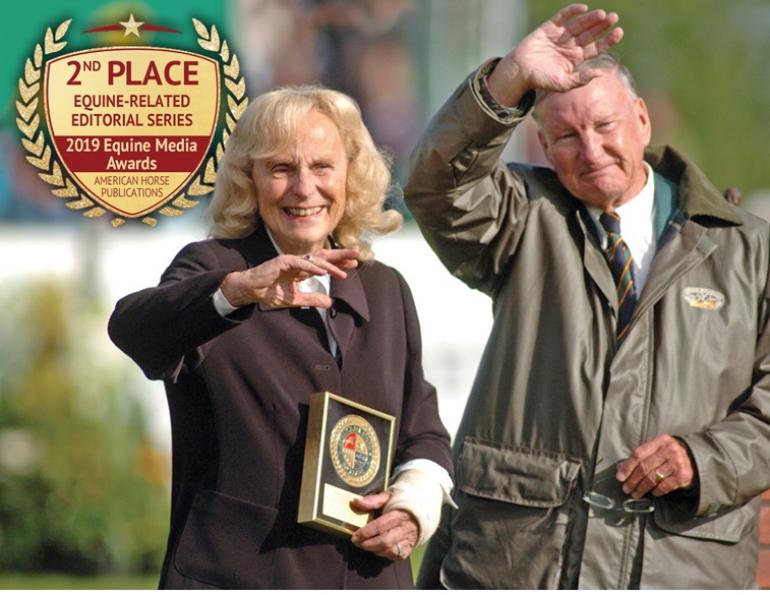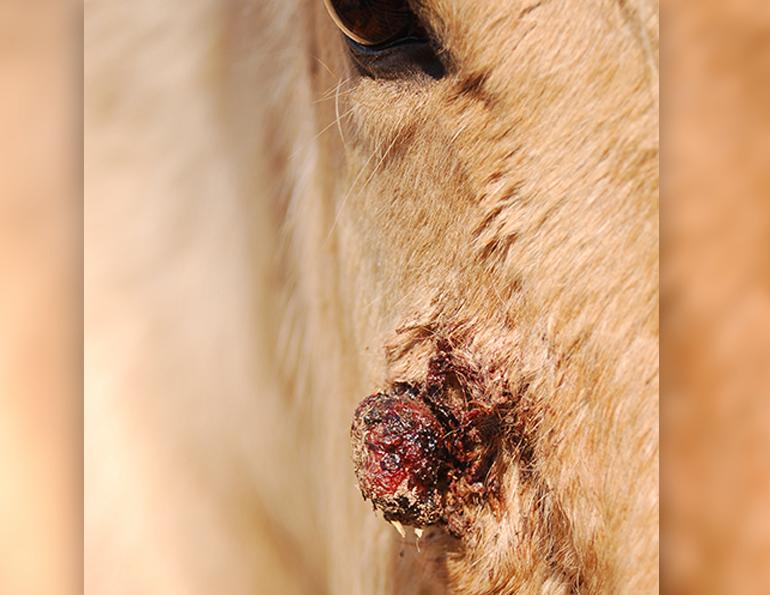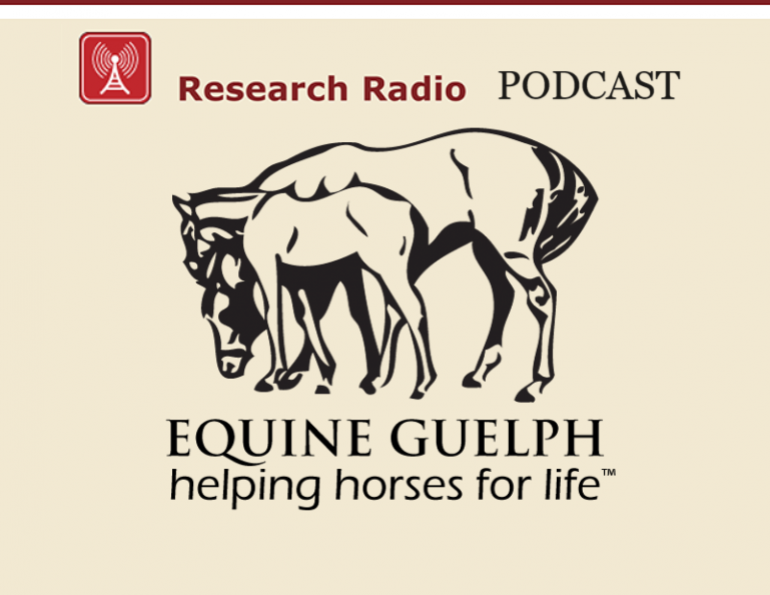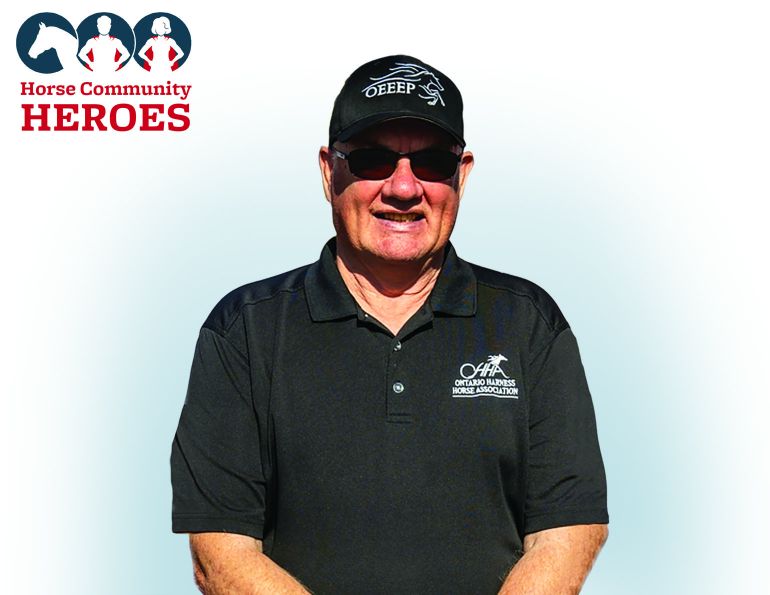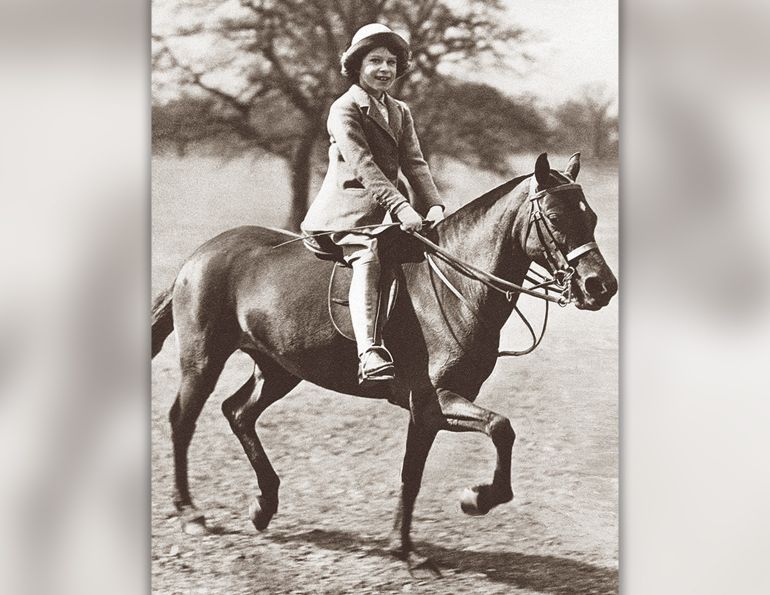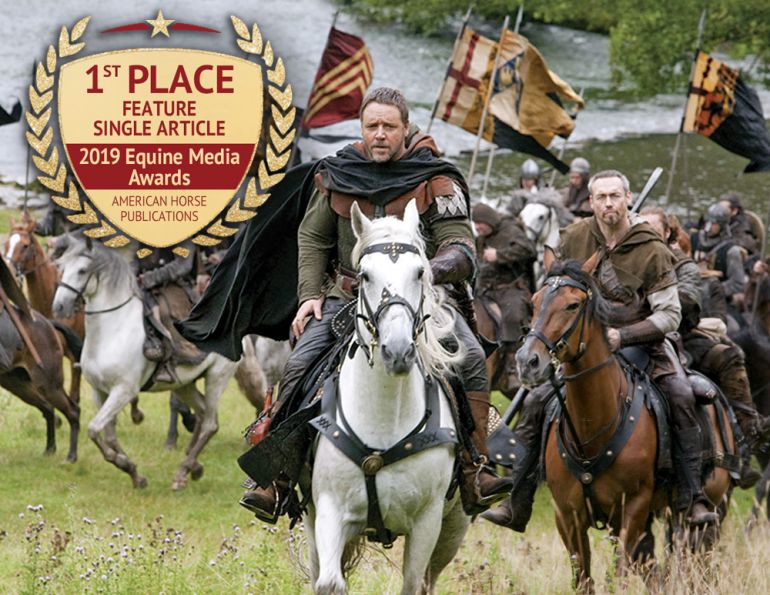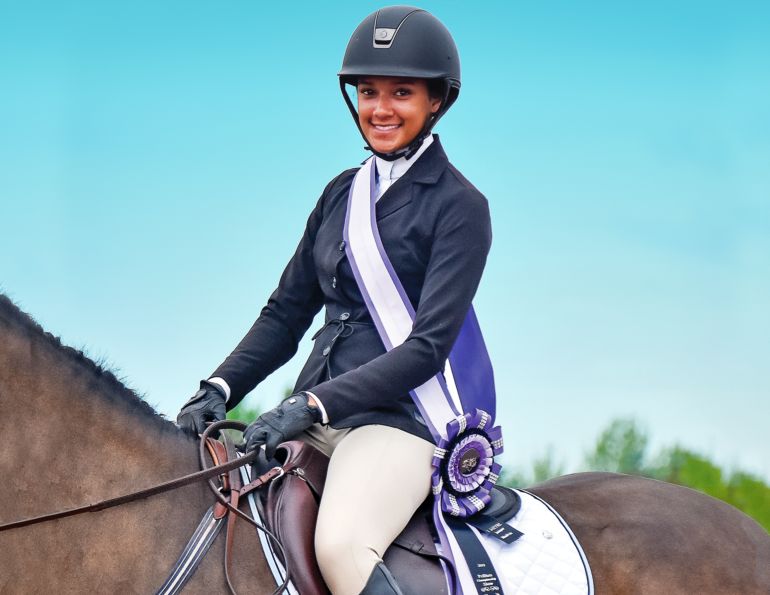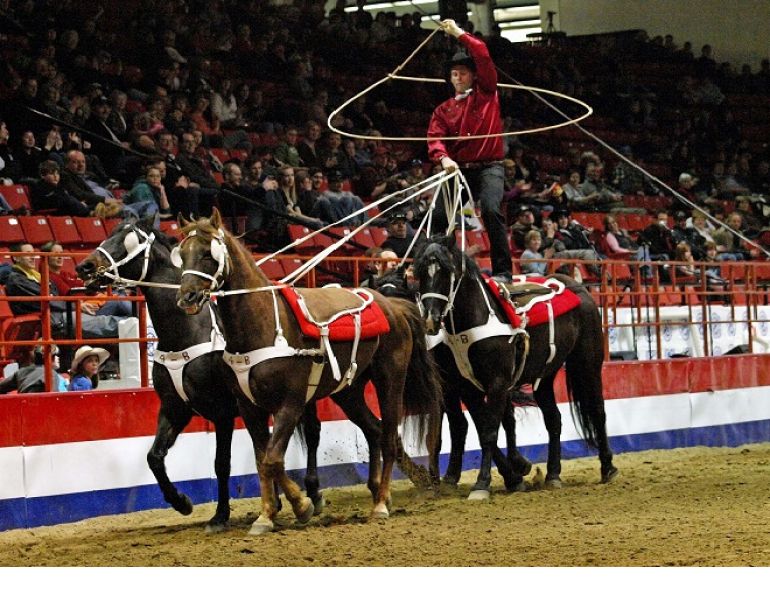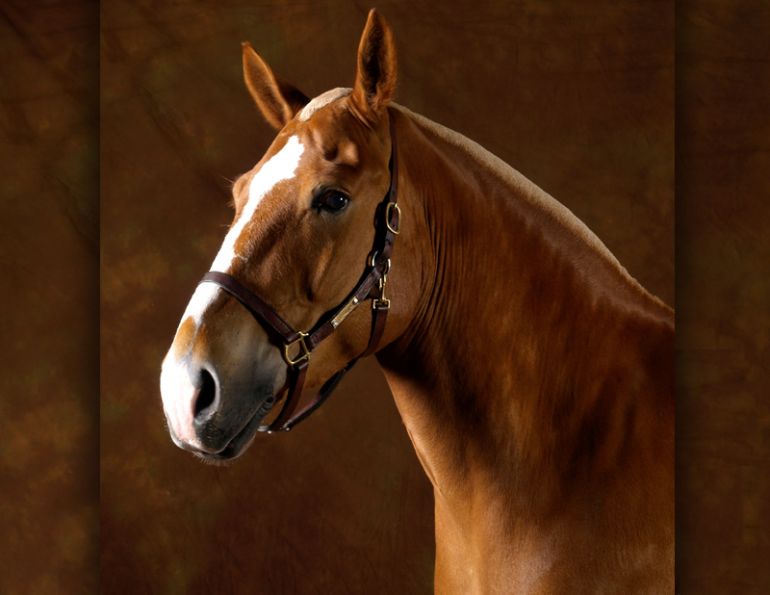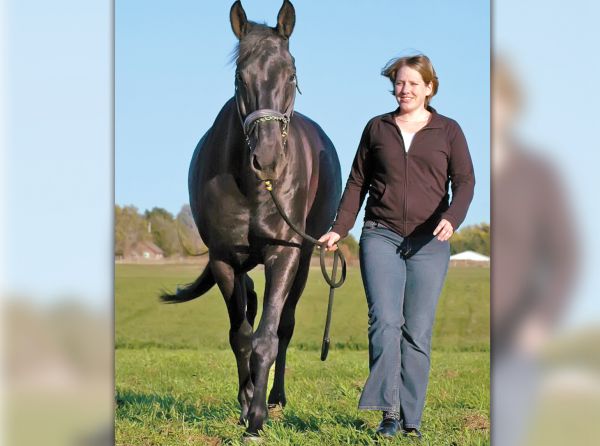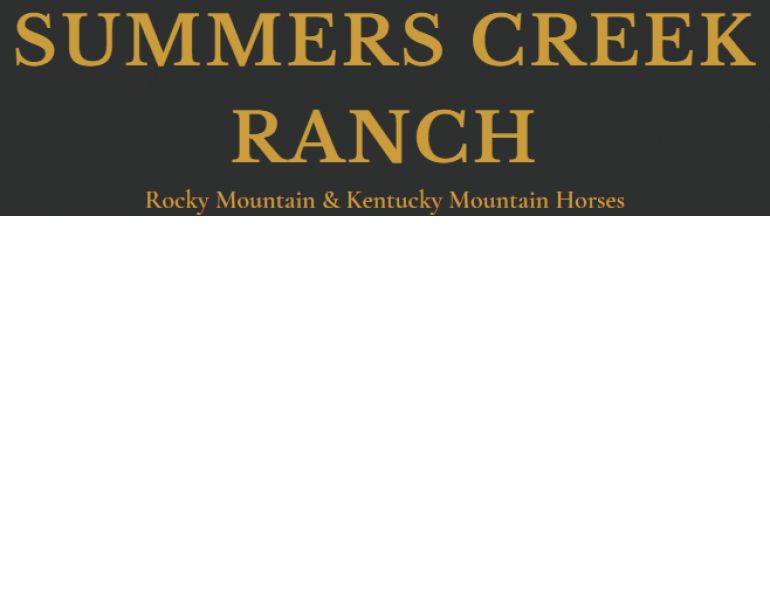Published in February 2018, this article highlights the remarkable individuals who have played a pivotal role in shaping and advancing Canada’s equine industry. These trailblazers have not only elevated the country’s position in the global equestrian community but have also inspired and motivated future generations of riders and horse enthusiasts. The success of Canada’s horse industry is driven by a diverse group of passionate individuals who demonstrate exceptional skill, talent, and commitment. In this feature, we celebrate a select few of these influential figures who have helped propel Canada to the forefront of the international equestrian scene.
Quick Links
- Bill Collins
- Faith Berghuis
- Peter Cameron
- Gayle Ecker
- David Esworthy
- Dr Gillian Lawrence
- Dr Sherman Olson
- Edward Plunket Taylor
- Guy Weadick
- Ron and Marg Southern
- George and Dianne Tidball
- Dr Hugh Townsend
- George Wade
- John Ware
- Alf Fletcher
- Jack Pemberton
- Cara Whitham
- John Scott
By Margaret Evans
In the history of cutting horse competition, Bill Collins is legendary. For over half a century, he devoted his life to Western equestrian sport by training horses, coaching riders, promoting the cutting horse industry, and upholding his values as a leader, visionary, and mentor. He was inducted into many Halls of Fame in the Western riding world including the Canadian Cutting Horse Association Hall of Fame (1987), Canadian Professional Rodeo Association Hall of Fame (1994), National Cutting Horse Association Hall of Fame (1995), and the American Quarter Horse Association Hall of Fame (2007).
In November, 1996, William (Bill) Collins, C.M., D.F.A. (Hon.) became a Member of the Order of Canada, and in recognition of his outstanding achievement, dedication and service described as follows: “He has played a major role in the preservation of Western Canada’s ranching history and tradition as a cutting horse and rodeo judge, trainer, and prize-winning competitor. One of those naturals who are born in the saddle, he has been an unofficial ambassador for Canada, sharing his rodeo skills and enthusiasm with equestrians around the world, particularly young people.”
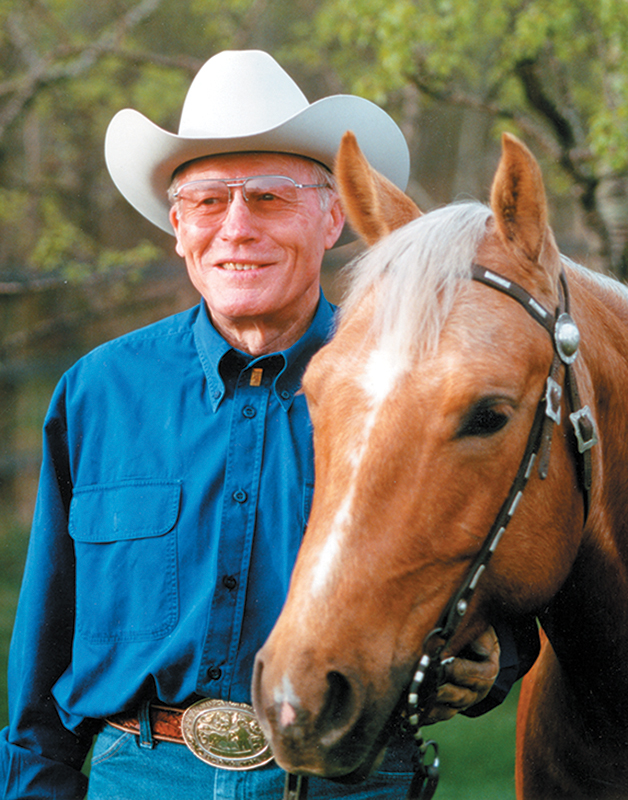
Bill Collins and Smarty Scotian Gold. Photo courtesy of Bill Collins
In 2000, Collins was given the inaugural Alberta Horse Industry Distinguished Service Award “In recognition of the magnitude and magnificence of his contributions to the equine industry in Alberta.”
Collins was born in 1924 in Big Valley, Alberta, some 60 kilometres north of Drumheller. His family was in cattle ranching. Riding horses and understanding cow sense became second nature to him. Then, in 1945 he attended his first Calgary Stampede where he instantly got the rodeo bug. The following year he returned as a competitor in calf roping and as an outrider in chuckwagon racing. He won Canadian Calf Roping Championships in 1951, 1952, 1956 and 1957. He was Reserve Champion in 1954, 1958 and 1959. He appeared on the cover of Sports Illustrated in 1954.
But his focus changed when, in 1955, a friend asked him to help out at a cutting horse demonstration in Bassano some 140 kilometres east of Calgary. He was hooked and soon after, Collins was asked to show a cutting horse for Leo Lemieux. One thing led to another and he began to travel to roping and cutting competitions. He would go on to become a three-time Canadian Cutting Horse Futurity Champion and win 12 Canadian Cutting Horse Open Championships.
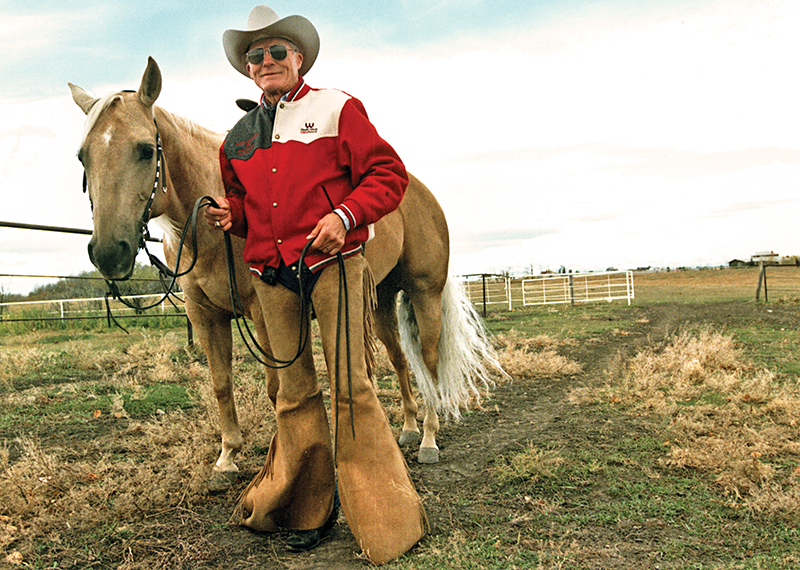
Bill Collins is one of Canada’s legendary horsemen. He has helped develop the sport of cutting in Canada and worldwide, has been a top rodeo competitor, and has mentored and taught thousands of Canadian youth. Photo courtesy of the NCHA
In 1958, Collins and Leo Lemieux joined with Cliff Ross, chairman of the Rodeo Committee, to lease Keillor Farm in Edmonton, Alberta (now Whitemud Equine Learning Centre), and set up Leecoll Stables. They soon had up to 75 horses in training in both English and Western disciplines. Collins was gifted with a wide range of Western and English equestrian talents. Teaching at Leecoll introduced Collins to show jumping, and it wasn’t long before he started helping the kids who were keen to jump fences. Collins excelled at show jumping, winning the Safeway Jumpers Sweepstakes at the 1966 Edmonton Rodeo after a jump-off over five-and-a-half-foot fences. Over the years, thousands of students would benefit from Collins’ talents as a teacher.
In 1962, his passion for cutting was taken to a whole new level. He was invited by Charles Nanby “Chunky” Woodward, then owner of Douglas Lake Ranch in British Columbia, to give a cutting demonstration for Prince Philip. Queen Elizabeth and Prince Philip were on a 23-day visit to Canada during which the Prince attended a Commonwealth Study Conference. On the agenda was Prince Philip’s visit to the renowned ranch.
The Prince was enthralled by Collins’ horsemanship and the skills of the cutting horse. The encounter led to a three-month visit to Great Britain in 1964 when Collins and his team, along with six cutting horses, demonstrated their skills and wowed crowds totalling a million people.
During the 1960s, Collins was a Director of the Canadian Equestrian Federation (now Equestrian Canada) and helped the organization to standardize judging rules. He introduced cutting to the Calgary Stampede in 1973 and was president of the Canadian Cutting Horse Association from 1979 to 1981.

Bill Collins and Peter Fraser at the 2009 Horse Breeders and Owners Conference in Red Deer, Alberta. Collins was outspoken about the starting of young horses at the event. Photo courtesy of Teresa van Bryce
Collins’ skills and expertise in giving clinics on cutting were in huge demand as were his skills as a judge. He judged competitions hosted by the Canadian Cutting Horse Association, National Cutting Horse Association, and the American Quarter Horse Association across North America and in Great Britain, Australia, Germany, and Switzerland.
At the 2009 Horse Breeders and Owners Conference in Red Deer, Alberta, Collins spoke out about starting horses too young, in particular the three-year-old futurities. “There’s the odd horse that can take it. The very odd one. So that’s why I said that I would change it from a three-year-old futurity in this country back to a four-year-old (futurity),” said Collins. “This three-year-old (futurity) has ruined more good horses, makings of good horses, than we’ve got in this country, and we’re raising a bunch of good ones now.” Collins stated many times how important it was to give young horses time to mature and understand what they are being asked to do.
Bill Collins’ legacy in cutting spanned over half a century and he is considered Canada’s all-time hero in the sport. On December 31, 2013, he passed away peacefully with his family at his side at the age of 89 years.
Faith Berghuis
By Margaret Evans
Faith Berghuis loved her Great Aunt Elsie, a very horsey person who lived at Franklands Farm in Brockville, Ontario, just down the road from the cottage where Faith’s family lived. Elsie Bedford-Jones and her daughter, Gwynneth, were active members of the Montreal Hunt, and Elsie was one of the first women to compete at Madison Square Gardens in New York. She lived on the shore of the St. Lawrence River, on an 80-acre farm that had been in the family since 1920 when Frank Jones purchased it from a descendant of the original Jones family that had come to Brockville just after the 1776 American Revolution. He gave the farm to his sister, Elsie, and she named it Franklands Farm after her brother.
One day in 1939, Auntie Elsie was coming to visit and four-year-old Faith had no idea then how much her aunt’s visit was going to decide the course of her life.
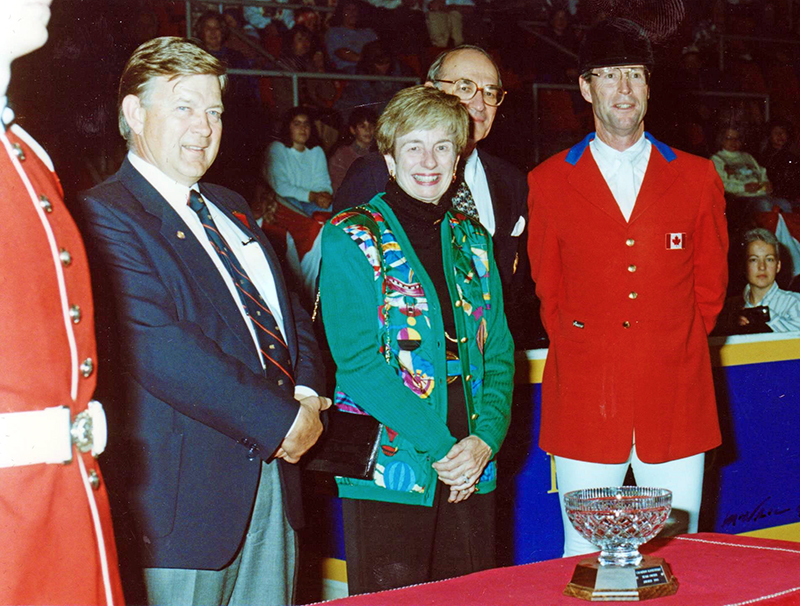
1995. Faith Berghuis receiving the first ever Team Owner Award for Show Jumping presented by Ken Peterson with Bill Berghuis and Ian Millar. Photo courtesy of Faith Berghuis.
“She arrived in her car,” recalls Berghuis. “She got out and opened the back door and out jumped a pony! It was tiny, just about nine hands. His name was Brucie and we had him at the cottage for the whole summer. He lived in a big doll’s house and I just couldn’t be separated from him. But he would go to my aunt’s farm in the winter. That’s how it all began.”
The seed was sown for a lifetime of horses, riding, and contributing to the equestrian industry by helping young, immensely talented riders with limited means to find and secure potential Olympic-level horses through the creation of syndicates.

Faith Berghuis at Franklands Farm. Photo courtesy of Faith Berghuis.
“I was from Montreal. I started in Pony Club when I was about ten. Our district commissioner was Barbara Kemp. The club used a stable on top of Mount Royal in the middle of the cemetery. I rode with Barbara a lot and we would ride among the tombstones. Many noted riders came out of Pony Club because of its very solid background.”
Barbara Kemp was the legendary FEI dressage and three-day event judge, official, and competition organizer who built the 1976 Olympic three-day event cross-country course in Bromont, Quebec, the first woman in the history of the Olympics to do so. Berghuis went on to become district commissioner of the Leitchcroft Pony Club in Toronto, and was quick to recognize how many talented riders graduated from the organization. She was equally astute to realize that so many gifted riders were hampered in their development toward excellence, and in their opportunities to represent Canada at the international level due to a lack of resources.
Elsie Bedford-Jones died in 1956 and her daughter inherited Franklands Farm. She continued the family tradition of breeding and showing outstanding horses. But Berghuis, who would inherit the farm on her cousin’s passing in 2000, set up syndicates that offered opportunities for people to become involved with the acquisition and development of elite level horses.
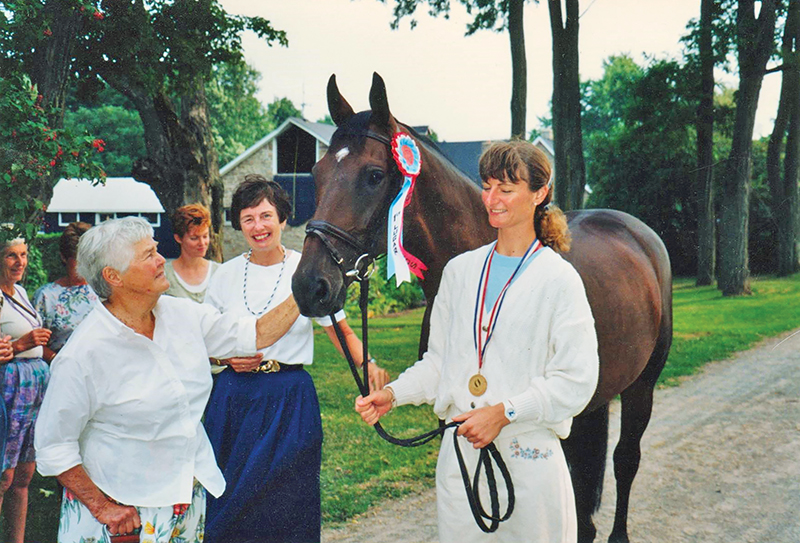
(L-R) Gwynneth Bedford-Jones and Faith Berghuis at Franklands Farm, welcoming Gina Smith and Dutch Treat home from the 1991 Pan American Games in Cuba, where they won team gold. Photo courtesy of Faith Berghuis.
The first such enterprise was the Big Ben syndicate known as Canadian Show Jumpers Unlimited Inc. established in 1983, which also included Warrior and Wotan. The next syndicate she organized was one that involved just her family and Ian Millar. Horse Futures Inc. brought in several prospects for Millar to develop, including Future Shock, Future Vision, El Futuro, and Future Folly.
As much as Berghuis supported show jumping through syndicate opportunities, she was also passionate about dressage. In the 1980s, Canadian dressage rider Gina Smith was training in Germany, and in 1988 Smith was named to the Canadian Olympic team with her horse Malte, and they won bronze at Seoul, Korea.
Meanwhile in Brockville, Ontario, horses were becoming too much for Gwynneth, now in her 80s. Berghuis discussed the problem with Ian Millar. She believed Gina Smith would be the perfect person to run the farm and set up a training business there, while she, Berghuis, would continue to form syndicates and partner in the acquisition of horses.
“Ian Millar and I went to Germany and we met with Gina,” she says. “Ian told her she was coming back to Canada! That was almost 30 years ago. She came back with Malte in 1990 and she is still with us. She is like family.”
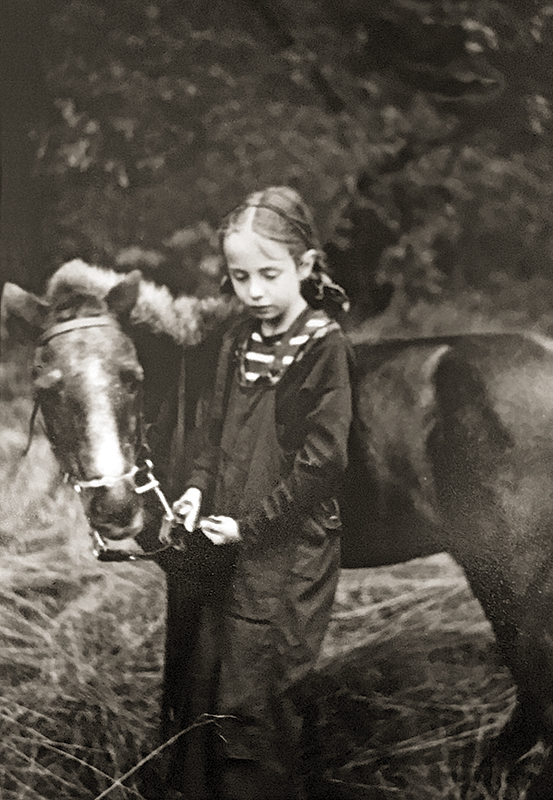
Faith Berghuis with her beloved first pony, circa 1938. Photo courtesy of Faith Berghuis.
Berghuis formed The Dressage Collection Inc. syndicate, and the first horse acquired was Faust, ridden by Smith at the 1996 Summer Olympics in Atlanta, Georgia, as part of Canada’s tenth-placed team. Berghuis inherited the farm in 2000, and returned to breeding top quality horses, which had always been a Franklands’ tradition. She continued forming syndicates, acquiring for Smith the grey Dutch warmblood, Fledermaus. The pair won the Swarovski Canadian League World Cup Final at the Royal Horse Show in 1999 and represented Canada at the World Cup Final in Holland in 2000. Currently another syndicate acquisition, Intrepid, is in training at the farm.
Today, Berghuis continues to see the pressure of costs limiting the scope of so many talented riders, and she worries about the future of the industry.
“It is beyond so many people’s means,” she says. “I feel sad about that situation. You see it in smaller communities like Brockville where so many people had fun. People have a hard time maintaining a horse, much less even going to horse shows. Even the horse shows are disappearing. Is it just a small clique that is going to benefit? For the most part, only the wealthy can afford to be involved with horses. Activity with horses is vanishing at the grassroots. I worry for the future. It is not a sport anymore. It is big business. I can help in a small way through the syndicates.”
And, indeed, she has.
Peter Cameron
By Margaret Evans
Few equestrian judges are as respected, admired, or celebrated as Peter Cameron. For decades he provided services as a judge, clinician, and speaker to a multitude of breed association shows and disciplines.
According to the Arabian Horse Association, Cameron judged a total of 885 horse shows over 46 years, and held 25 judging cards. In 2014, he received the Lifetime Achievement Award from the Arabian Professional and Amateur Horsemen’s Association, automatically inducting him into their Hall of Fame. It was the first time a Canadian, and a judge, had ever won the award. It ranked with special pride among his many accolades including induction into The Arabian Horse Association Judges Hall of Fame, The Ontario Quarter Horse Hall of Fame, The Arabian Horse Association of Southern California Hall of Fame, The Can-Am Equine Emporium Walk of Fame, The St. Catherines Sports Hall of Fame as an Athlete, and The City of Thorold Wall of Fame as an Athlete. He also received two Judge of the Year awards from the Arabian Horseman’s Association. In 2015, the Ontario Equestrian Federation honoured him with its People Make a Difference Award, dedicated to those who work tirelessly behind the scenes to support Ontario’s equestrian community.
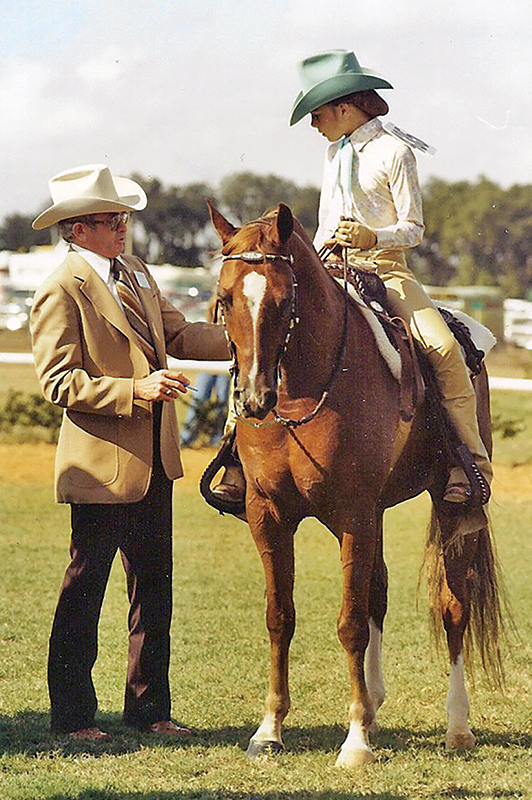
Cameron has very high standards for judges, which he strictly adhered to during his career. Photo courtesy of Peter Cameron
Born in St. Catharines, Ontario, Cameron began riding at the age of six. At age 15, he purchased his first show horse. In an interview with J.L. Orchard for the article Becoming the Judge: The Life and Lore of Peter Cameron published in Canadian Horse Journal in March 2010, Cameron explained that for his first show he travelled eight hours on horseback to compete. “I rode the horse 35 miles to Hamilton on Friday, placed third on Saturday, then rode home on Sunday.”
Very quickly, Cameron’s talents as a rider and trainer became evident. While he was accomplished in a wide variety of sports including baseball, lacrosse, basketball, and ice hockey, he truly excelled as a judge in the show ring. And that opportunity came about purely by accident.
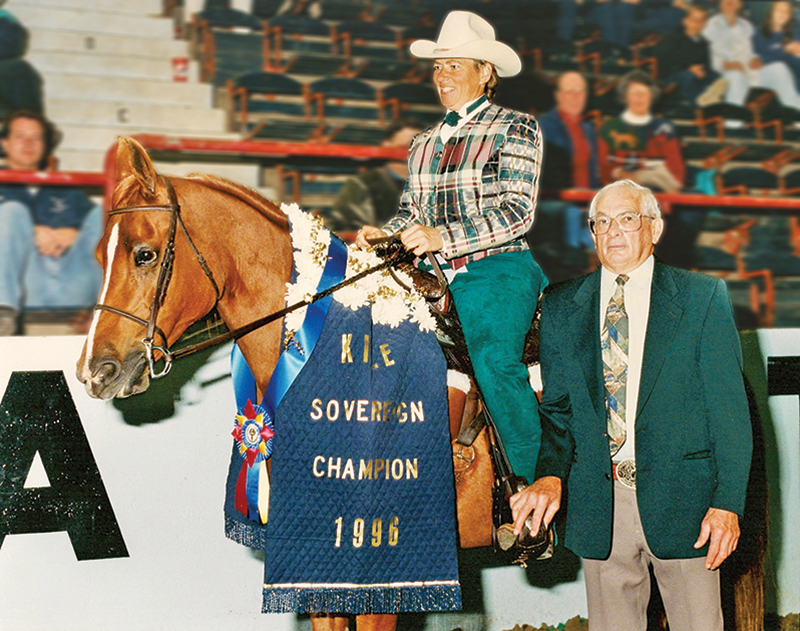
His great integrity and dedication made Peter Cameron the most prolific Canadian horse judge of all time. He judged 885 horse shows in his career. Photo: Brian K. Richman, courtesy of Peter Cameron
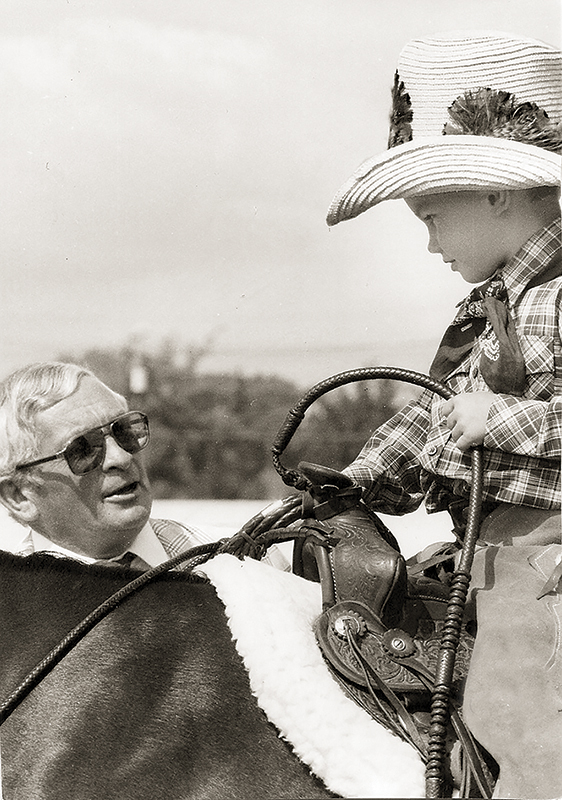
Cameron loves kids and would often give mini-clinics during youth classes. Photo: Dodo Knight, courtesy of Peter Cameron
In the Becoming the Judge article, Cameron describes attending a show in Hamilton with two horses he had trained. But the judge retained for the show had been delayed in a car accident. Frantic to solve a critical problem, the organizers asked all trainers to throw their names in a hat and the one drawn would be judge for the day. Cameron’s name was drawn and his career as a much-loved and respected judge was launched.
He was a gentleman’s judge with integrity, honour, and great humour, a man who never went back on his word. In the ring he worked in the moment, judging every horse no matter whether there were five or fifty on the rail. And he never allowed past knowledge, preconceived notions, or connections – however remote - to interfere with his critique.
Cameron judged at all the very best breed championships and shows including Calgary’s Spruce Meadows, Toronto’s Royal Winter Fair, Vancouver’s Pacific National Exhibition, Scottsdale All Arabian in Arizona, Texas State Fair, Quarter Horse Congress, and the US National Arabian Show. He was the first Canadian to judge at the American Quarter Horse World Championship show.
But more than casting a discerning eye as a judge, he saw the potential in each rider. As a father and grandfather, Cameron especially enjoyed children and would on occasion give a mini-clinic during a youth class. He offered advice when needed and made it clear to competitors what he wanted to see without ever placing riders in embarrassing or awkward situations. His skills, talents, and demeanour as a judge set the bar for all those following in his footsteps.
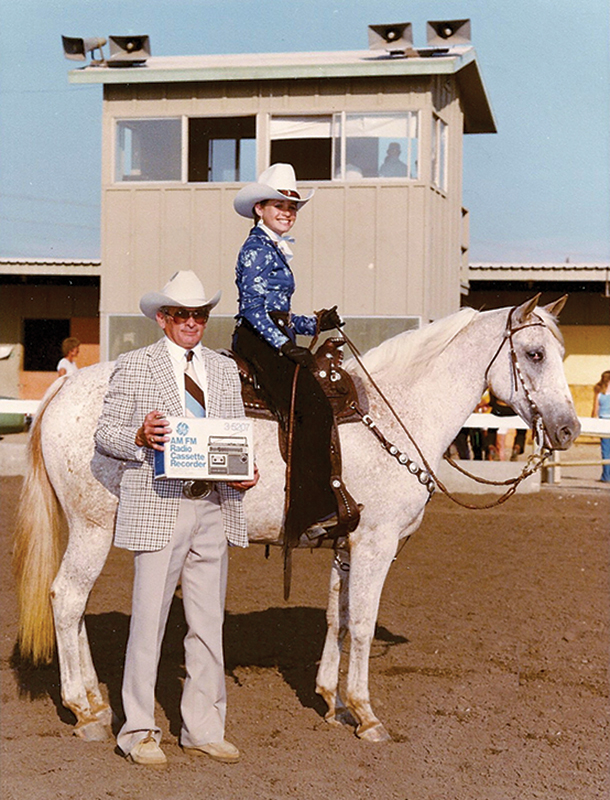
Photo: Glenn Carol, courtesy of Peter Cameron
Cameron knew that a good attitude is as essential as recognizing a good horse. “Sometimes it’s necessary to stand out in the arena for up to 12 hours a day in all kinds of weather,” he commented during the interview with J.L. Orchard. He had empathy and no shortage of patience for his competitors.
“My favourite thing about being a judge was I got to see the best horses in the world from the best position in the ring,” he noted. “And I was getting paid for it.”
He retired from judging in 1996 but continued to give clinics, speeches, and offer evaluations of horses. He resides with his wife, Velma, in St. Catharines, Ontario.
Gayle Ecker
By Margaret Evans
If there is one thing Gayle Ecker is truly passionate about it’s the health and welfare of horses, and she has made it her life’s work as director of Equine Guelph at the University of Guelph in Ontario.
That devotion to horses led to Ecker being awarded the prestigious Equine Industry Vision Award in 2015. The award, presented by the American Horse Publications and sponsored by Zoetis, recognizes Ecker’s innovation, vision, and commitment to the equine industry. And it all began with Pogo.
“Pogo was my best friend,” says Ecker who was born in 1958. “He was a dappled grey Shetland pony with a forelock covering his eyes. I would have been in Kindergarten. I learned to ride bareback as we didn’t have a saddle. I don’t even remember, but my mother put me on a horse before I could walk. It’s a family joke about me having no choice but to go into a horse career!”
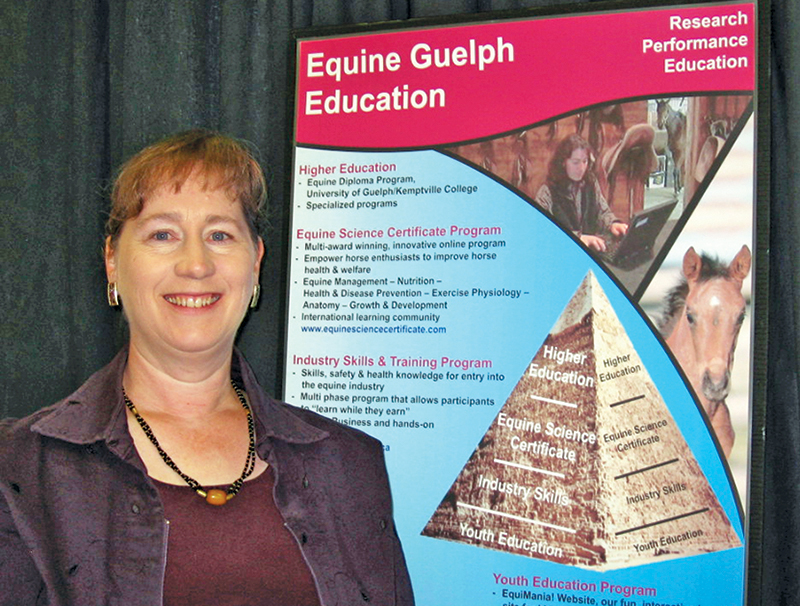
Photo: Equine Guelph
Ecker’s youth was spent enjoying 4-H activities, which naturally led to volunteer work with the organization. She started at the University of Guelph in 1988, working for the Equine Research Centre in research and education. She was part of the creation team that set up Equine Guelph, and has been its director since it opened in 2003.
Three things have defined who she is since that inception: horse welfare, research, and education.
“It’s a pyramid and all have to go together,” she says. “They are fully intertwined as the welfare of the horse is so critical. I am all about evidence-based knowledge to support horse health, welfare and safety.”
Ecker knew, though, that there were many people who loved horses, or who were fascinated by horses, but knew nothing about them. To reach them, she followed an educational pathway that would have a global reach.
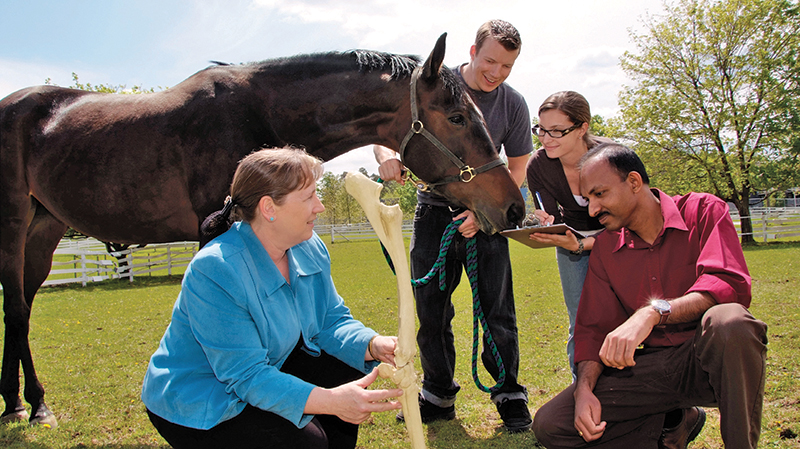
Photo courtesy of Susan Raymond, PhD.
“We started building online courses and we now have over 20, making us a world leader,” she says proudly. “No one else is doing this from an accredited university. And the cool thing is that we now have students from over 40 different countries because it’s online. It’s so cool to think about – global horse enthusiasts coming together online to learn about horse health, welfare, and safety.”
Gayle also has her sights set on youth, and this led to the creation of a unique program called Equimania. Many children today are raised in an urban environment with no opportunity to grow up around animals. But the spark of interest is there and Ecker wants to grab it and help children hold on to it through Equimania’s challenges and quizzes. With a zero-budget each year, volunteers, sponsors, and in-kind donors step up to the plate to take the program to the Royal Agricultural Winter Fair in Toronto (11 years), and the Can-Am All Breeds Equine Expo (10 years). And it was the only Canadian exhibit invited to the 2010 World Equestrian Games in Lexington, Kentucky.
Ecker says that parents look at the horse industry and see the cost. But kids love Equimania, and it opens the door to reach their parents who begin to see the horse industry in a very different way because the presentation stresses careers and educational pathways to careers.
“I think what makes Gayle unique is her belief that the future of our relationship with the horse is absolutely predicated on the education of horse people and the public at large,” says Jeffrey Wichtel, professor and dean, Ontario Veterinary College, University of Guelph. “There are many individuals that contribute energy and talent to support the health and welfare of horses, and the human-horse relationship more broadly, but Gayle stands out as one who has dedicated most of her life to this goal — she lives and breathes this. I agree that knowledge is the key for every horse person to understand and effectively share the huge responsibility we have for these amazing animals under our care, and Gayle’s vision has filled an important gap.

Gayle Ecker receives the Equine Industry Vision Award from Kate Russo of Zoetis. Photo: Equine Guelph.
“Gayle’s online students are not just students to her; she takes a personal interest in all of them and works hard to ensure the knowledge transferred is current, relevant, and immediately applicable. The numbers don’t lie - enrolment in her programs just keeps growing year over year. Every young person she interacts with, whether through Equimania, an online course, or in one of her many other offerings for youth, is seen as critically important for the future of the industry.”
For Ecker, the greatest challenge, and opportunity, is education.
“I would like to see horse education become more mainstream,” she says. “In the UK, there is the British Horse Society and its absolutely part of the [equestrian industry] tapestry. In Canada, thousands get into the horse industry with no training. We are creating a learning community within Canada through the Horse Portal.”
The Horse Portal provides industry training in an easily-accessible online format to bring horse people together and help them stay current on best health and welfare practices. “I am very optimistic about that program with its potential to develop and grow, and it will become that learning community beyond the provincial federations and Equestrian Canada.”
David Esworthy
By Margaret Evans
Among the most dedicated Canadians to influence the horse industry is David Esworthy. Born on January 29, 1929, he became one of our most respected and honoured horsemen, and served in almost every role in equestrian sport as a rider, FEI judge, FEI steward, clinician, show organizer, show chair, administrator, and industry advisor.
Esworthy’s influence was felt in all layers of the industry, but perhaps his greatest contribution was his mentorship of so many individuals who went on to become accomplished athletes, officials, and administrators in their own right.
Described as a consummate horseman, his involvement in organizations was legendary. As judge, steward, and clinician, he travelled to many parts of the world to attend events including Germany, Australia, New Zealand, Thailand, and Brazil.
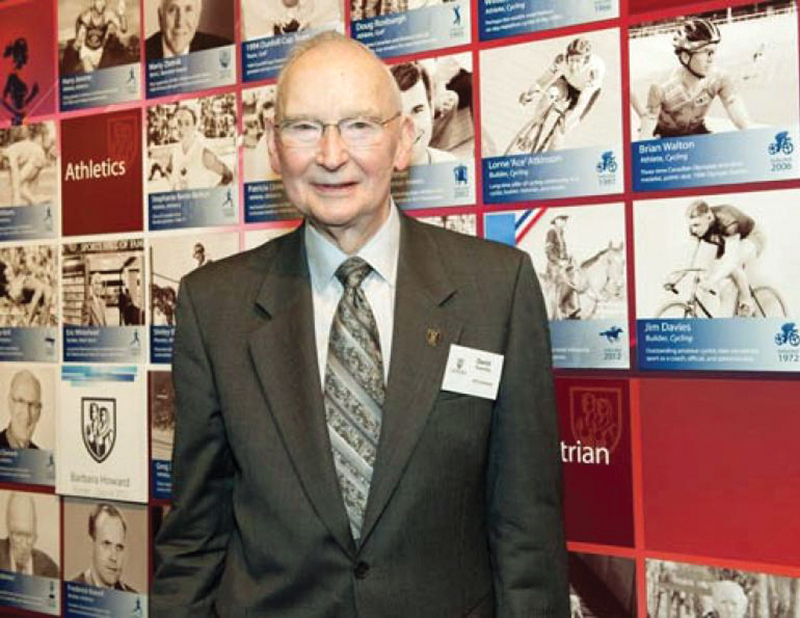
Photo: BC Sports Hall of Fame
In 2012, he was named Jump Canada Official of the Year for his outstanding contribution and dedication to the sport.
That same year, the BC Sports Hall of Fame added “Equestrian” as a sport discipline and Esworthy was the first to be honoured under that banner when he was inducted in the Builder category for his lifelong contribution to the equestrian community.
He had come a long way from his teen years wrangling horses at his aunt’s lodge.
“Raised largely in Vancouver, Esworthy’s start with horses came in his teens wrangling horses during summers at the famous Rainbow Lodge,” says Jason Beck, curator and facility director of the BC Sports Hall of Fame. “Owned by his aunt, Myrtle Philip, the lodge later became Whistler Village, although in those days there wasn’t even a gravel road connecting the area with Vancouver. Some of his best horse education came from horsemen such as Francis Howard, who worked the string of horses there taking guests on rides.”
Esworthy studied agriculture at the University of British Columbia and worked for two years on a ranch in the BC Interior (which apparently, according to Beck, cured him of any desire to be a cattle rancher). But it was there he met his future wife, Pat. Back in Vancouver, he and his young family began riding at Northridge Riding Club, and he soon became the club’s instructor. When the club folded, he continued riding at Southlands Riding Club and served as its president from 1969 to 1972. During this time, his reputation for training difficult horses became widespread.
While Esworthy worked for 40 years at Hastings Brass Foundry – the last four in his career as president and CEO – he always found endless volunteer hours for equestrian sport.
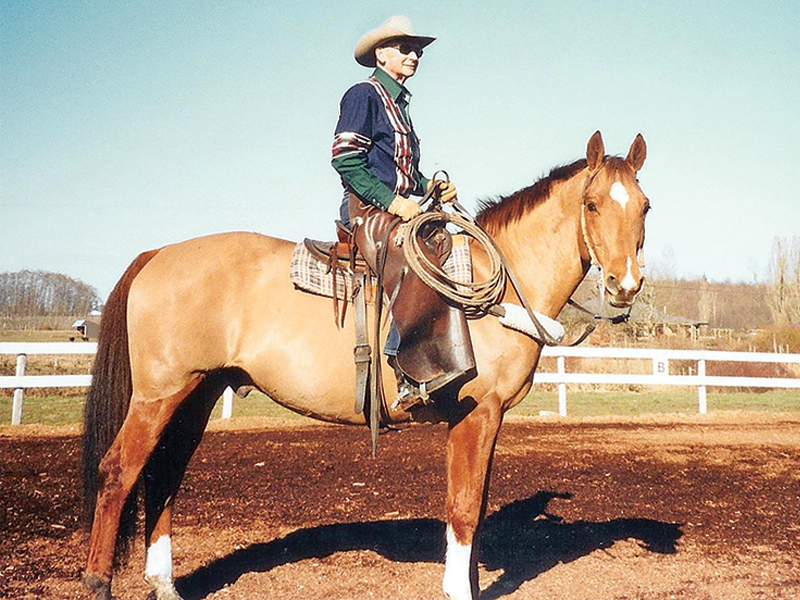
Photo: BC Sports Hall of Fame
“He stands as one of only two Canadian Federation Equestrian Internationale (FEI) stewards who held tickets in all three Olympic disciplines,” says Beck. “Serving as an FEI international judge for many years in some of the world’s most prestigious events, he also taught judging clinics and exams around the world. He assisted in the preparations for equestrian events at both the 1976 and 1984 Olympic Games.”
From 1968 to 1977, Esworthy served as chair of the BC Zone of the National Equestrian Federation and vice-president of the national body.
“At the same time, he served as a director on the Canadian Horse Council and found himself at the centre of the greatest restructuring in Canadian equestrian history when the two organizations combined,” says Beck. “Esworthy emerged as president of the newly-formed Canadian Equestrian Federation (now Equestrian Canada), serving in that capacity until 1984 and as chairman from 1984-91. One of his greatest accomplishments was writing the new organization’s constitution and bylaws, which included clauses for the formation of stronger provincial organizations. As a result, the creation of Horse Council of British Columbia can be credited to Esworthy as well.”
On December 19, 2015, Esworthy passed away at the age of 86 in Langley, BC. But he will forever be remembered for the indelible marks he left on so many aspects of the equestrian world. He inspired so many with his passion for horses, infectious smile, and eternal willingness to help and share his knowledge. Throughout his life he took the meaning of the word “dedication” to a whole new level.
Dr. Gillian Lawrence
By Margaret Evans
Dr. Gillian Lawrence devoted her life to medicine, children, and horses. Born in England where she began her medical career as a family physician, she came to Canada in 1965 with her family and they settled in Amherst, Nova Scotia, where her husband, the late Dr. George Anthony (Tony) Lawrence, was a surgeon in Cumberland County. Tony was a great nephew of the famed novelist D.H. Lawrence.
Lawrence devoted her life to the therapeutic riding movement in Canada. She was passionate about children, horses, and medicine and it was a natural fit for her to create a therapeutic riding program at the family home of Burnside Farm that would run for over 30 years.
She was a founding member and first president of the Nova Scotia Riding for the Disabled Association and helped fledgling groups set up therapeutic programs. At the national level, Lawrence was a founding member and past-president of the Canadian Therapeutic Riding Association (CanTRA), which was formed in 1980 and today has over 80 centres. CanTRA promotes therapeutic riding for people with disabilities and maintains the standards for riding as a therapeutic, recreational, and sports activity in close collaboration with the medical profession. Lawrence chaired the medical committee and her specialized knowledge guided the writing of the Instructor Certification Manual. The Manual is still a valued reference guide for the several hundred CanTRA-qualified instructors working to provide developmental riding experiences for people with disabilities.

Photo courtesy of CanTRA
According to Equestrian Canada, Lawrence represented Classification on the International Para-Equestrian Committee, and served on the Jury of Appeal at several events. In 1991, she became Chef d’Équipe and led Canada in its first venture into international para-equestrian competition. She filled the Chef d’Équipe position again in 1994, helping Canada to a silver medal finish at the World Dressage Championships in Hartpury, England.
She was instrumental in the development of the classification of disabilities in para-equestrian sport and served as an International Classifier at the debut of Para-Dressage competition during the 1996 Atlanta Paralympic Games and again at the 2000 Sydney Paralympic Games.
Lawrence loved people. She was involved in launching a number of social programs in Amhurst including Meals on Wheels and the local food bank. In 2008 she received the Paul Harris Fellowship presented by the Amherst Rotary Club for community service.
On August 20, 2013, Lawrence’s contribution to the Canadian equestrian community was officially recognized by the Governor General’s Caring Canadian Award, one of 46 volunteers from various sectors across Canada to receive the honour. Lawrence received her award during a ceremony at Rideau Hall on April 7, 2014 and the event highlighted National Volunteer Week.
CanTRA had sponsored Lawrence as a candidate for the award.
Created in 1995, the award recognizes Canadians who have made a significant, sustained, unpaid contribution to their community in Canada or abroad. They are often people who work behind the scenes, giving willingly of their time and efforts to help others. The award highlights the example they set in which their compassion and engagement profile Canadian character. In 2015, Equestrian Canada awarded Lawrence with The Lifetime Achievement Award, given to an individual whose contributions to the Canadian equestrian community are considered exceptional by their peers and whose long-term service and dedication contributed directly to the ongoing growth and development of the equestrian sport and industry.
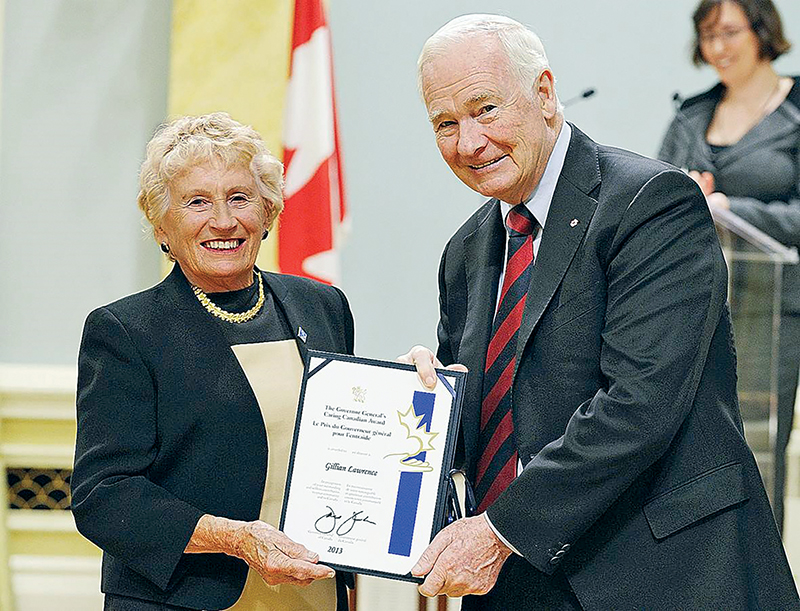
Dr. Gillian Lawrence accepting the 2013 Governor General’s Caring Canadian Award from Gov. Gen. David Johnston. Photo: © MCpl. Vince Carbonneau, Rideau Hall
Lawrence had been diagnosed with breast cancer, but that didn’t slow her down. She formed a support group for other breast cancer survivors in the Amherst area, providing constant support and, for several years, competed in the Jump for Hope class for breast cancer.
The Jump for Hope is a fundraising event at St. Lazare that was launched in 2006 by the Royal Victoria Hospital Foundation for the Cedars Breast Clinic at the McGill University Health Centre. Many breast cancer competitors had never ridden a horse so the challenge to ride over fences became symbolic of facing and conquering the challenging fear of a cancer diagnosis. The challenge and its meaning were a perfect fit for Lawrence’s own values.
Lawrence passed away at home surrounded by her family and four-legged friends on May 31, 2016 at age 83. A poignant obituary summarized all that Lawrence meant to so many:
“Even more significant than her incredible volunteer work were the everyday thoughtful deeds. She referred to herself as a simple country doctor, but to her patients she was so much more — she was caring and brilliant. Gillian provided a glowing example of how to live and love life. She touched the world in a positive light in so many ways and leaves a legacy of pure joy, class, and love.”
Dr. Sherman Olson
By Margaret Evans
Dr. Sherman Oakley Olson of Maple Ridge, BC, was born in Saskatchewan in 1928 and moved to Vancouver in 1941 where he attended King Edward High School. He studied optometry at the College of Optometry, University of Chicago, and graduated in 1951.
For almost 20 years, Olson ran his optometry practice from the Birks Building at Granville and Georgia Streets, Vancouver, before moving his family to Maple Ridge in 1971.
Olson and his wife Josephine had two daughters, one of whom was born with cerebral palsy. Olson served as president of the Vancouver Cerebral Palsy Association and was the founding chairman of the BC Neurological Society. He was also president of the BC Association of Optometrists and worked diligently to bring about provincial legislation that brought optometrists under the Medical Services Plan so their services would be covered. He was instrumental in the launch of Optofair, an annual education and tradeshow event for optometrists. His vision for the benefit of such a trade show resulted in the first Optofair in 1980.
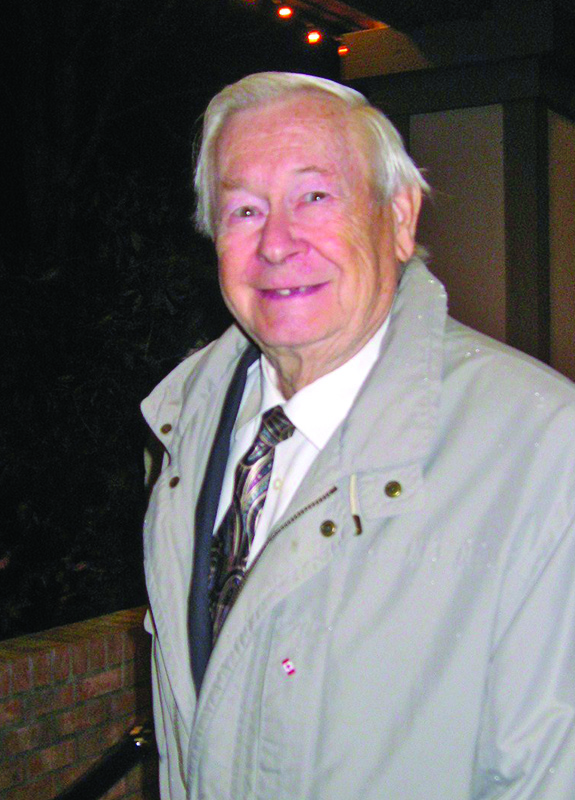
Photo courtesy of Horse Council BC
It was as an optometrist that he met lifelong friend, Bill Archibald, in 1970. Olson’s younger daughter, Nancy, had a passion for riding and Archibald, who was a member of the Planning and Parks Board, was a trail advisor for the BC Recreation Association. Horses were in their lives and the organization of the equestrian community became a focus of their mutual concern.
In British Columbia, two organizations were in play – BC Horse Owners Association and the Equestrian Federation of BC. But Olson and Archibald saw the value of a single organization that would work for the good of all riders — Western and English alike. From that vision was born Horse Council of British Columbia with Olson acting as founding president from 1980 to 1990. In 1981, Olson was the first to receive HCBC’s Lifetime Achievement Award. In 2013, following Olson’s passing, it was renamed the Sherman Olson Lifetime Achievement Award.
Olson, along with partners, purchased the Maple Ridge Riding Centre and operated it as a community resource from 1974 to 1984. He was involved with the Canadian Horse Shows Association that would become the Canadian Equestrian Federation (CEF), Equine Canada, and now Equestrian Canada. He served as director of the CEF from 1981 to 1986, vice president from 1986 to 1996, and vice-president recreation 1999-2003. He was active in the restructuring of CEF and its constitution to serve members better by developing programs such as the certified coaching program, fundraising for national and international competitions, and insurance plans.
Organizational skills were in Olson’s blood. In 1982 he chaired the committee that hosted the first FEI-recognized Young Riders Championships held in Maple Ridge, which was the first of its kind in Canada. Competitors came from across the country, the US, and Mexico.
But perhaps it was his devotion to trails and trail riding that earned Olson the greatest accolades. In 1992, to commemorate Canada’s 125th anniversary, he coordinated the national relay “Ride for Canada.” According to The Trails Society of British Columbia, “This highly publicized event involved equestrian enthusiasts from across Canada taking four months to cross the country. The relay from coast to coast to coast concluded on Parliament Hill in the presence of her Majesty the Queen. He was honoured and received a Governor General’s Award for this project.”
In 1993, Olson became a director of the Trans Canada Trail Foundation, and then President from 1995 to 2001. He provided ideas and guidance for provinces to complete their section of the trail. It was a huge dream but by putting in the hard work and taking one step at a time he provided the leadership and inspiration for others to take up the cause and turn the Trans Canada Trail into today’s reality.
The official opening of the trail was both poignant and emotional. Three original relay containers carried water from Canada’s three oceans. The relay ended in Hull, Quebec, and the waters were combined symbolizing “Unity, pride, and love for our country.”
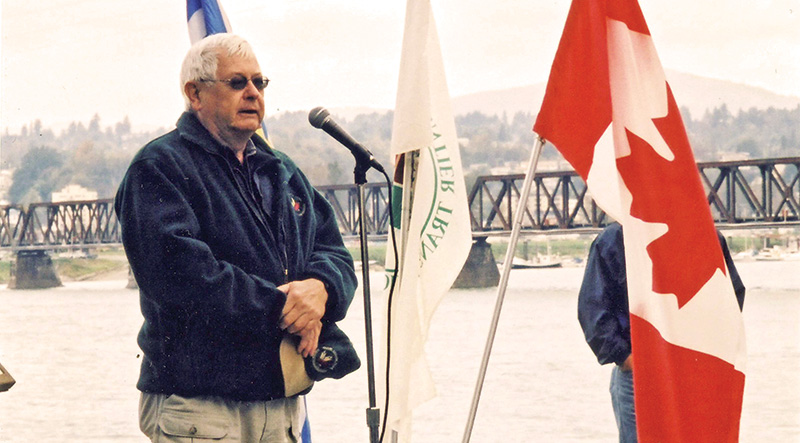
Dr. Sherman Olson at a Trans Canada Trail dedication at Matsqui, BC. Photo courtesy of TrailsBC website.
In 1998, Olson was named Equine Canada’s Volunteer of the Year for his dedication, hard work, and vision that helped shaped Canada’s equestrian community.
Closer to home, Maple Ridge was a huge beneficiary of Olson’s skills. According to the Maple Ridge-Pitt Meadows News, he served on the hospital board and the hospital foundation, the Chamber of Commerce, the Arts Council, Maple Ridge Community Foundation, and the Economic Advisory Council.
Olson passed away suddenly June 9, 2013 at age 85. On June 23, 2017, he was awarded posthumously Canada’s Meritorious Service Medal. It was presented to his daughter Nancy Olson-Beaulieu by the Right Honourable David Johnston, Governor General of Canada, in recognition of his vision for the Trans Canada Trail as a symbol of a unified Canada, and his ability to motivate thousands of volunteers to harness their energy and make the project a reality. The award recognizes extraordinary people who make Canada proud.
Ron and Marg Southern
“The dream of the Southern Family from the start was to create a unique environment of ‘good friendship, good commerce and good sport.’” – The Spruce Meadows website.
Through commitment and passion, the family saw their dream become a reality in 1975 when their newly minted Spruce Meadows in Calgary, Alberta, officially opened. Over the years the magnificent facility would bring international acclaim and numerous awards, but the path that led to those achievements began decades earlier.
Ron, born in 1930 in Calgary, met his wife Margaret (nee Visser) born in High River in 1931, when they were classmates at Calgary’s Crescent Heights High School. They married in 1954 and soon two daughters, Nancy and Linda, came along.
In 1947, Ron Southern together with his father S.D. Southern, created their business Alberta Trailer Hire with the purchase of 15 utility trailers designed to meet the housing needs of oil industry workers. The business grew to become ATCO Ltd., then ATCO Group, an Alberta-based worldwide organization of companies with assets in the billions of dollars and three business divisions including power generation, utilities, and global enterprises.

Marg and Ron Southern at the Masters tournament in 2005. Photo: Robin Duncan Photography
Both Nancy and Linda became competitive riders and their passion for equestrian sport sparked Ron and Marg’s decision to create a world-class equestrian facility. In 1971, they purchased a feedlot south of Calgary and, in 1973, broke ground to start construction. Spruce Meadows held their official opening ceremonies on April 13, 1975.
As a result of the leadership and vision of the Southern family, the facility quickly became Canada’s premier show jumping venue, and was soon recognized internationally. Over the next four decades, Spruce Meadows became an iconic sports venue recognized as one of the world’s leading venues for international and national jumping competitions.
The first two tournaments held in 1976 were The National Tournament (called International), and the Masters Tournament.
By 1979, annual attendance reached 50,000. Expansion and upgrades continued and the inaugural $85,000 du Maurier International (the world’s richest grand prix) was held in 1981. In 1982 the tournament list expanded to The National, Canada One, North American, and The Masters. The first Equi-Fair was held in 1983, and in 1984 Ian Millar brought Big Ben to Spruce Meadows for the first time. Over $1 million in annual prize money was awarded for the first time in 1987.
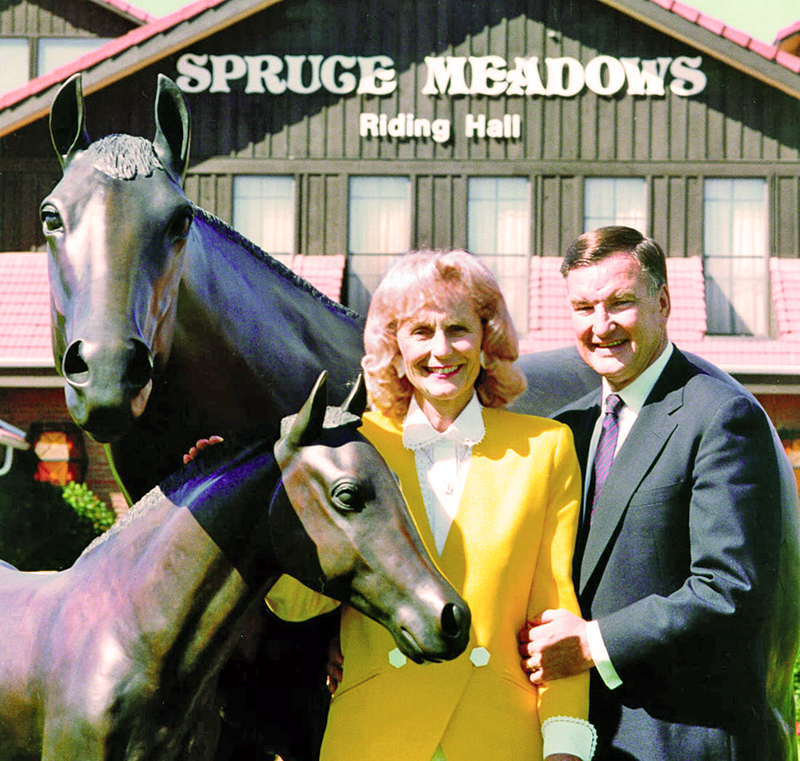
Marg and Ron Southern with the horse bronzes commissioned for the visit of Her Majesty Queen Elizabeth II in 1990. Photo: Spruce Meadows
In 1988 Her Majesty Queen Beatrix of the Netherlands visited the facility and, in 1990, Her Majesty Queen Elizabeth II visited, with Marg Southern riding in the coach seated beside the Queen.
The year 2000 saw Spruce Meadows hold the first million dollar grand prix in the world at the Masters, and that same year two athletes, Canada’s Ian Millar and Great Britain’s Michael Whitaker, surpassed the $1 million mark in lifetime earnings at the venue. Spruce Meadows was voted the number one outdoor show jumping venue in the world in 2002 and 2004. In 2013, the first Pan American tournament was held.
Over the decades competitors, spectators, and visitors alike came to know Spruce Meadows for its commitment to excellence, outstanding competition, and memorable experiences. Today, Spruce Meadows is home to two indoor riding arenas and seven outdoor grass jumping arenas, the most significant of which is the famed Spruce Meadows International Ring, recognized as the most renowned, challenging, and potentially rewarding show-jumping stadium in the world. The facility has 85 full-time employees and capacity for 1,000 horses in ten permanent stables. Tournament attendance is well over 400,000 annually, and Spruce Meadows events on television and the internet reach up to a billion viewers. Over $6 million in prize money was won at the venue in the 2017 season.
Ron Southern’s success as a Canadian business icon led to his investiture as a Member of the Order of Canada in 1986 and in 2006 he was promoted to Companion of the Order of Canada, for those who have demonstrated the highest degree of merit to Canada and humanity on the national or international scene. He was inducted into the Canadian Business Hall of Fame in 1995.
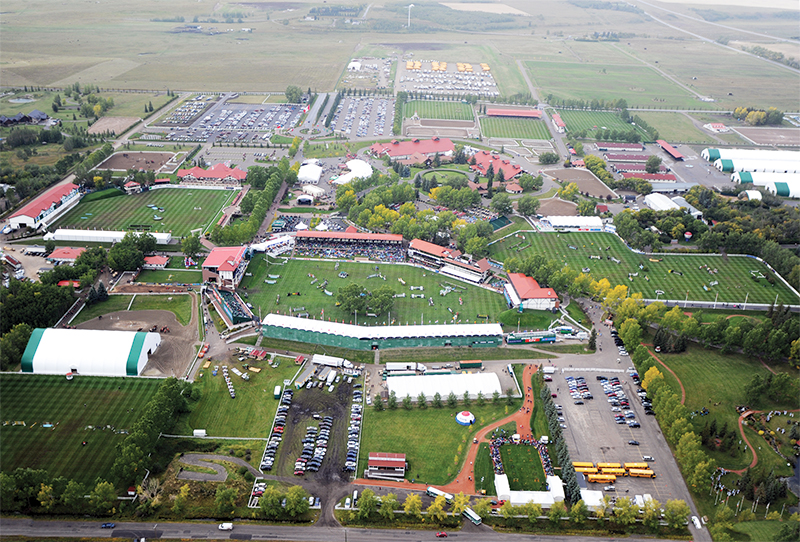
Aerial view of Spruce Meadows show jumping facility. Photo: Robin Duncan Photography
In 1992 the Southerns were inducted into the Alberta Sports Hall of Fame & Museum. Ron was inducted as a Member of the British Empire in 1990 in recognition of his promotion of commerce, culture, and sport. He was promoted to Commander of the British Empire in 1995. In 1987 Marg was made a Member of the Order of Canada and promoted to Companion of the Order of Canada in 2007 for having “demonstrated passionate leadership and commitment to sport as a professional and volunteer.”
In 2006 Ron and Marg Southern were inducted into the Canadian Sports Hall of Fame in the category of Builder. In 2008 they were inducted into the Jump Canada Hall of Fame, and the Alberta Horse Industry Distinguished Service Award was bestowed on them in 2001. The Queen Elizabeth II Diamond Medal was awarded to Ron and Marg Southern in 2012 by His Honour Donald S. Ethell, Lieutenant Governor of Alberta.
In 2015, Spruce Meadows celebrated its 40th anniversary. As prominent as it has become on the world stage, its founders never forgot its modest beginnings as a facility for everyone, offering accessibility to the sport of show jumping and the world of the horse. An excerpt from the Canadian Sports Hall of Fame website reads: “In the early years the Southerns had no idea of the heights to which Spruce Meadows would rise. They built the facility for everyone, hoping to provide integrity and accessibility to the sport of show jumping and to the world of the horse. They created Spruce Meadows based on the tradition of the equestrian sports and a simple recipe of hard work, good friendship, good commerce, and good sport.”
In January 2016, at the age of 85, Ron Southern quietly passed away with Marg and his daughters at his side.
Edward Plunket Taylor
By Margaret Evans
Canada’s best-known Thoroughbred breeder, E.P. Taylor, was born in Ottawa, Ontario, in January, 1901, into a wealthy family. He attended Ashbury College, an independent day and boarding school founded in 1891. Taylor graduated from McGill University, Montreal, in 1922 with a degree in mechanical engineering but he soon became involved in his grandfather’s brewing business, Brading Brewing, which he inherited.
Taylor’s entrepreneurial spirit soared. With his Midas touch, he built a financial empire throughout the 1930s by buying up and merging 20 other small breweries to create Canadian Breweries Limited (now Molson Coors Brewing Company) that would grow to be one of the world’s largest brewing companies. Merging and modernizing became the hallmark of his career.
During World War II he served Mackenzie King’s government as one of the famed “dollar-a-year” men (business executives who helped the government mobilize and manage industry during wartime), connecting with top businessmen around the world. After the war he and his partners founded Argus Corporation, a powerful holding company with interests throughout Canada’s economy from grocery stores to forestry to mining. At the top of his game, Taylor was one of Canada’s richest businessmen.
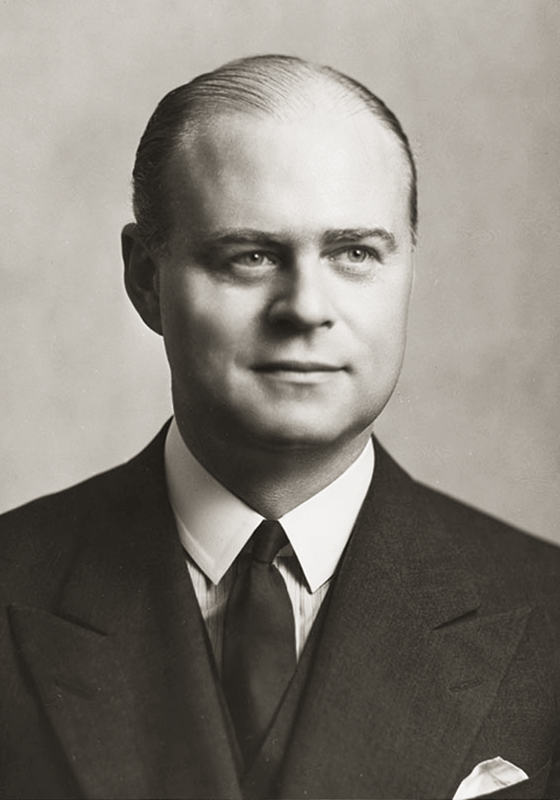
E.P. Taylor. Photo: Library and Archives Canada/e002505493
But if he was a luminary entrepreneur, he was a legendary Thoroughbred racehorse breeder. Just as he was the architect of his phenomenal business dealings, he became the architect of modern racing and breeding.
Taylor was introduced to horseracing at Blue Bonnets Raceway during his university days. In the 1930s, together with business partner Jimmy Cosgrave of Cosgrave Breweries, he established Cosgrave Stable. One of its notable racehorses was the chestnut filly Mona Bell which, in 1938, was Canada’s champion three-year-old “Queen of the Sprinters,” winning the Maple Leaf Stakes and the Breeders Stakes. She was inducted into Canada’s Horse Racing Hall of Fame in 2000. Her full sister Iribelle, owned by Taylor, produced Canadiana (by Taylor’s stallion Chop Chop), the first Canadian-bred racehorse to earn more than $100,000 purse money.
In the 1950s, Taylor and his wife Winnifred established Windfields Farm in Oshawa, Ontario, and Taylor became president of the Ontario Jockey Club from 1953 to 1973. He took his business savvy and applied it to the racehorse industry, consolidating many of Ontario’s unprofitable race tracks. He built a new Woodbine Racetrack in 1956 while improving the facilities at the old Woodbine (later named Greenwood), and Fort Erie.
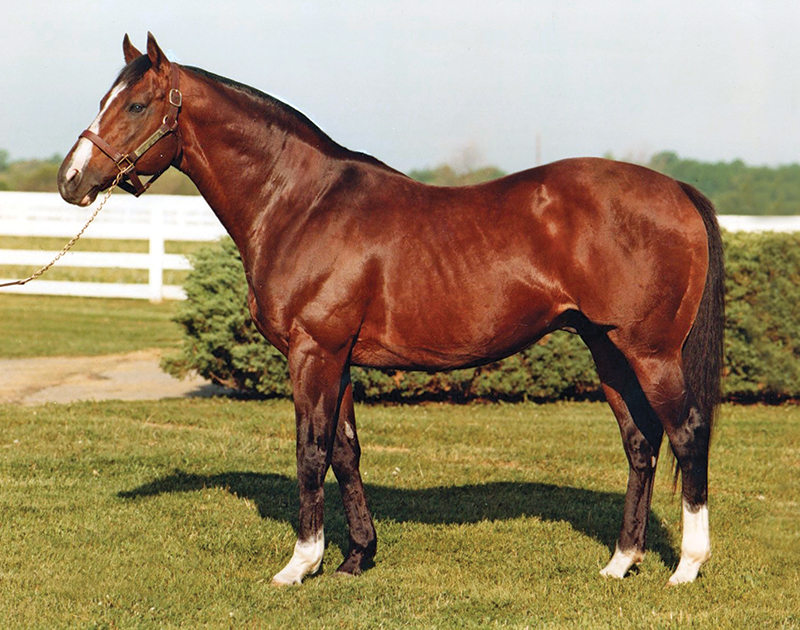
Northern Dancer. Photo: The Tony Leonard Collection
Taylor didn’t know it at the time, but 1961 would be a turning point in his life. In his barn a feisty little bay colt was born on May 27. He didn’t grow a lot. In fact, Taylor put the unruly 14.2 hand Thoroughbred in the 1962 yearling sale but he didn’t even fetch the $25,000 reserve. The colt, Northern Dancer, had other things in store for his owner.
As a two-year-old, Northern Dancer had seven wins in nine starts and earned the Canadian Juvenile Championship. People began to take notice. Then in 1964 as a three-year-old, Northern Dancer won the Kentucky Derby and two weeks later he won the Preakness Stakes. He placed third in the Belmont Stakes, then returned to Canada to win the Queen’s Plate in June of 1964. In his two years of racing he won 14 of his 18 races, never finishing worse than third. He was the first Canadian-bred horse to win the Kentucky Derby, and remains the only horse to win both the Kentucky Derby and the Queen’s Plate.
But if he was brilliant as a racehorse, Northern Dancer was legendary at stud. He became the leading male-line progenitor of modern Thoroughbreds worldwide throughout his breeding years from 1965 to 1990. By 2000 his influence on the breeding industry was considered the greatest in the 20th century. He sired over 400 winners, including 146 stakes winners, across North America and Europe and his stud fee rose to $1 million. Northern Dancer was inducted into Canada’s Sports Hall of Fame in 1965, the first horse to be honoured. Taylor himself would be inducted into Canada’s Sports Hall of Fame in 1974 in the Builder category.
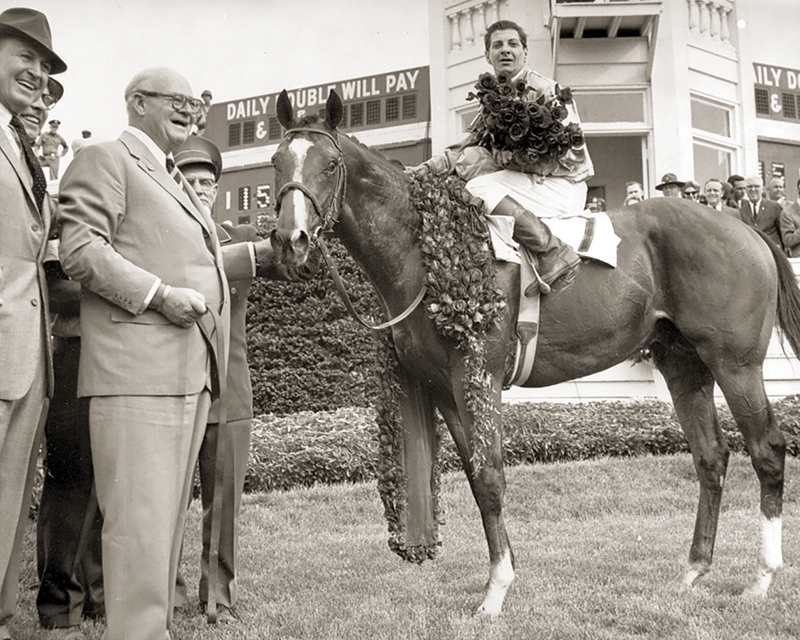
Northern Dancer with owner E.P. Taylor and jockey Bill Hartack after winning the Queen's Plate in 1964.
As a Thoroughbred breeder, Taylor produced many phenomenal winners and stallions at stud that went on to major acclaim. Bull Page, Canadiana, Nearctic, Victoria Park, Canebora, Northern Dancer, and Victoria Era all received the Sovereign Award for Canadian Horse of the Year.
Taylor was the world’s leading horse breeder in 1970 measured by money won. He was voted Thoroughbred racing’s Man of the Year in 1973 and was elected to Canada’s Sports Hall of Fame in 1974 in the Builder category. In 1977 and 1983 he was named the winner of the Eclipse Award for Outstanding Breeder as the leading Thoroughbred breeder in North America. He won the Eclipse award for Man of the Year in 1973; the Sovereign Award for Man of the Year in 1975 and 1977; and the Sovereign Award for Outstanding Breeder in 1976. In 1996 he was inducted into the Ontario Sports Hall of Fame. Horses he bred or owned won 21 runnings of the Queen’s or King’s Plate, and more than 320 stakes races worldwide. Taylor was also a founder of the Jockey Club of Canada.
Taylor retired to his home in the Bahamas where he passed away in 1989.
George and Dianne Tidball
By Margaret Evans
Langley has long been reputed as the “Horse Capital of British Columbia” and spearheading the provincial equestrian industry have been George and Dianne Tidball, founders of the renowned Thunderbird Show Park. The venue regularly hosts FEI level competitions attracting some of the biggest names in equestrian sport compete. Today they are remembered for their brilliant business acumen and are honoured inductees of Jump Canada Hall of Fame in the Builder category (2009), BC Sports Hall of Fame in the Builder category (2017). Horse Council BC awarded Dianne with a Lifetime Achievement Award for her accomplishments in BC’s equestrian community.

Okanagan sweethearts Dianne and George Tidball. Photo courtesy of Thunderbird Show Park
Dianne was born in 1932 in Shanghai, China, (where her father managed the manufacturing company Lever Brother’s Far East Division) and George was born in Carstairs, Alberta. Their paths crossed when they both attended BC’s Penticton High School, graduating in 1951. They married in November 1952. But it was during a short stay in England in Dianne’s early years while living with her family at the company town of Port Sunlight, when she took riding lessons and fell in love with horses. It would put her and George on a path to destiny.
George, with Dianne’s encouragement and support, cut his business teeth as a chartered accountant and his first job was with Alcan in Kitimat, BC. Offered a scholarship at Harvard University, the couple moved to Boston where, two years later, George graduated at the top of his class as a Baker Scholar. It led to employment and business opportunities. Back in Canada, George was consulting for forest giant MacMillan Bloedel, but Dianne missed the family-friendly fast food at McDonalds and urged her husband to explore a franchise. Dianne’s instinct for opportunities resulted in George opening the first McDonald’s restaurant in Western Canada in Richmond, BC in 1967. He built 32 McDonalds restaurants before selling out and starting his own restaurant chain in 1971 – The Keg (originally called The Keg and Cleaver).

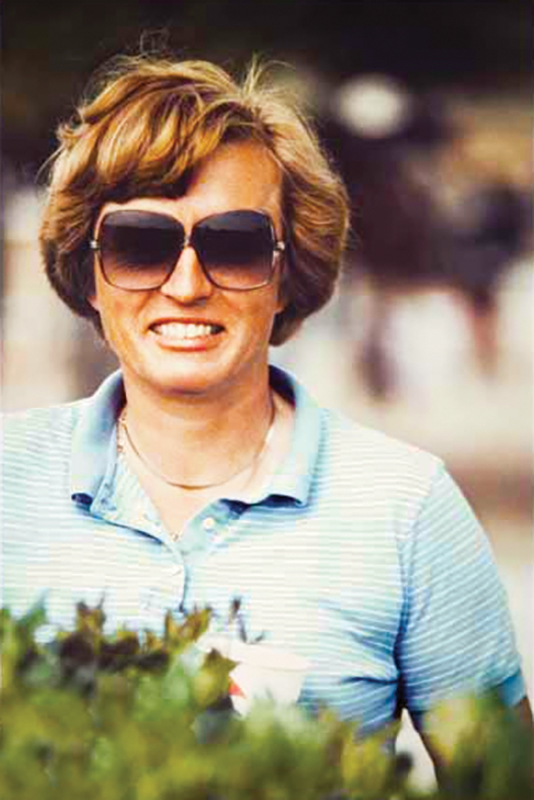
Photos courtesy of Thunderbird Show Park.
In 2005, George was inducted into the BC Restaurants Hall of Fame, receiving the Pioneer Award for his contribution to the industry over the course of his career.
The Tidballs purchased land in Langley and built the Thunderbird Equestrian Centre in 1973 at 200 Street and the Trans-Canada Highway, which rapidly became a go-to equestrian facility for top shows and competitions. Dianne bred and trained BC’s first homebred AQHA champion. Daughter Laura Tidball-Balisky was a two-time member of the Olympic Show Jumping Team (1984 and 1988); their sons, like George, were avid ropers; and daughter Jane became Thunderbird’s president and tournament director.
In 2000, they sold the land to developers.
“The Tidballs decided to build their dream show facility from the ground up and within two years under Dianne’s leadership the 85-acre Thunderbird Show Park, located among Langley’s picturesque rolling hills and tall trees at 248th Street and 72nd Avenue, was born,” says Jason Beck, curator and facility director, BC Sports Hall of Fame. “Designed by the firm that planned the 1996 Atlanta Olympics equestrian venue, Thunderbird featured six competition rings, including one of North America’s best grand prix fields with permanent grandstands, five warm-up rings, three indoor arenas, five covered stables, a golf course, riding trails, and state-of-the-art footing. Dianne managed the facility until 2005, when daughter Jane took over.”
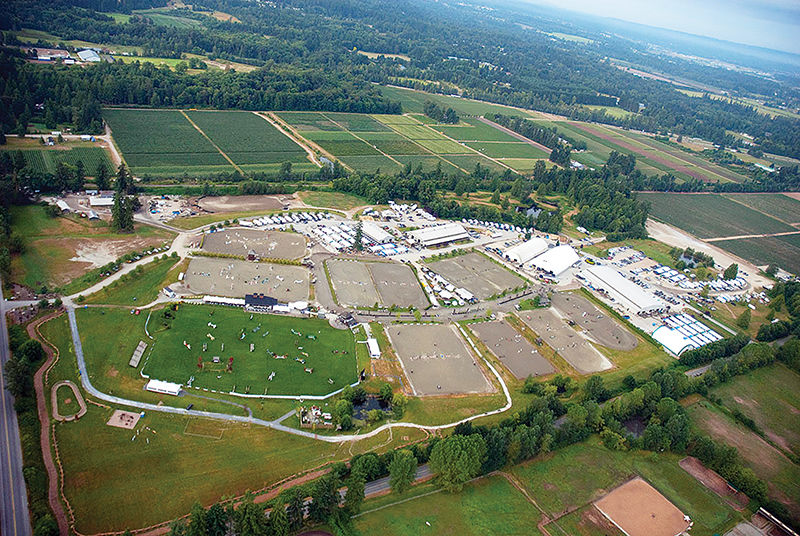
Aerial view of Thunderbird Show Park. Photo: Totem Photographics
FEI level competitions are regularly held at Thunderbird, drawing some of the biggest names in the sport including Canadian Olympic medalists Eric Lamaze, Ian Millar, and Jill Henselwood, as well as international competitors from around the world. Since 2011, the North American Riders Group has ranked the Thunderbird Grand Prix event among the top three in North America with three straight years at number two from 2013-15.
On June 3, 2014, George passed away at age 83 surrounded by his loving family. Then, just 18 days later on June 21, Dianne passed away at age 81.
With their business instincts and acumen, and their trust and faith in each other, the Tidballs were truly equestrian industry builders leaving a legacy of benefit to everyone.
Dr. Hugh Townsend
By Margaret Evans
Some highly talented people come along in the horse industry and they go on to enjoy high profile careers and become household names. Others work quietly in the background, yet the impact of their valuable work is felt across Canada and around the world.
Dr. Hugh Townsend is one such person. He held positions as a research scientist and program manager at the Vaccine and Infectious Disease Organization-International Vaccine Centre (VIDO-InterVac)), University of Saskatchewan; an adjunct professor in the Royal University Hospital’s Department of Community Health and Epidemiology; a founding member of the faculty of the School of Public Health as an infectious disease and veterinary internal medicine specialist at the Western College of Veterinary Medicine’s (WCVM) Department of Large Animal Clinical Sciences; and as co-leader of the university’s One Health initiative. The latter program is an approach to foster the well-being of people, animals, and the environment by collaborative problem-solving at all levels — regionally, nationally, and globally.
Born and raised in Calgary where his father was a senior orthopedic surgeon, Townsend attended the universities of Calgary and Guelph. He began his veterinary career in 1973 before becoming a research scientist at the Vaccine and Infectious Disease Organization at the University of Saskatchewan. His career included more than 120 publications; he was the university’s Horse Health Lines and the associate editor (experimental design and statistics) of the Journal of Veterinary Internal Medicine.

Photo: Myrna MacDonald, courtesy University of Saskatchewan.
Throughout his illustrious career, Townsend has been the recipient of many awards including the Pfizer Animal Health Award of Excellence (WCVM); the University of Saskatchewan “100 Alumni of Influence” Award (University of Saskatchewan); the Stan Olson Clinical Teacher of the Year Award (WCVM); and the Saskatchewan Horse Federation – Farm Animal Council of Saskatchewan Award of Distinction (Equine Welfare Communication).
Townsend was instrumental in setting up the Equine Health Research Fund (later to be known in tribute to him as the Townsend Equine Health Research Fund). Since 1977, the Fund has provided financial support to train equine specialists in surgery, internal medicine, reproduction, epidemiology, and pathology. Research grants are advanced for equine health-related studies and research projects, the results of which have prompted a variety of diagnostic and therapeutic advances in horse health now used throughout the world.
At first, though, the EHRF didn’t have its own capital to launch the research projects. Townsend’s father and brother stepped up to help. His father connected the college with horsemen in Alberta who would provide some financial support and his brother connected the WCVM with Calgary and Edmonton business communities. Today, the Fund invests over $100,000 annually in equine health research projects, a research fellowship program for graduate veterinary students, and a summer research program for undergraduates. It has provided research grants to more than 150 health-related studies conducted by WCVM researchers and collaborators, and promoted equine health education and awareness among the equestrian community through seminars, industry meetings, and the Fund’s news publication Horse Health lines.
“I was an Equine Health Research Fund Fellow way back,” says Dr. James Carmalt, professor of equine surgery and an equine surgical specialist at the WCVM. “He was one of my mentors during my internship and he was the kind of mentor who didn’t micromanage. He gave advice when you asked for it and he was generous with his time and knowledge. Some of the research done here is groundbreaking. Without the basics and basis of the health research fund we wouldn’t have had the research platform to do any of it.”
Carmalt came from Cambridge, England, to study at the University of Saskatchewan and he was the first EHRF-sponsored graduate student to undertake a residency in equine practice at WCVM. Carmalt says that the influence and guidance of Townsend changed his whole career. That influence, that mentoring, became legendary with the Townsend name.
When the EHRF was renamed the Townsend Equine Health Research Fund in 2015, Jeanette Neufeld wrote in the press release, “A chance conversation with Dr. Hugh Townsend outside the Western College of Veterinary Medicine (WCVM) led Dr. Joe Bracamonte to focus his career on equine health. ‘He changed my career in the parking lot, just with a conversation,’” Bracamonte, an associate professor specializing in large animal surgery, told Neufeld.
Neufeld wrote that Townsend had a gift for inspiring people to pursue equine-focused veterinary medicine. In addition, she says, he has left a lasting legacy in the fields of equine internal medicine, infectious disease, and vaccinology as well as a legion of researchers who have been inspired by him.
He was a practical clinician as well as a creative researcher. He set high standards and would review people’s proposals against those high standards.
“When West Nile virus came, making its way from New York across the US and into Canada, Hugh and his colleagues saw that coming,” says Dr. Doug Freeman, Dean, WCVMedicine, University of Saskatchewan. “They used [that situation] as an opportunity to set up a trial looking at vaccinated and unvaccinated populations in a newly emerging disease. He always stayed ahead of the curve. He was a very inspirational person to be around.”
And he was fun to be around. Freeman says that he was quick to laugh and had a really bright spark in his eye.
“He sees positive things and sees humour,” he says. “I can’t think of a conversation I had with Hugh when he didn’t burst out with laughter at one thing or another.”
George Wade
By Margaret Evans
George Wade was born in 1917 in Kentville, Nova Scotia and attended school there, completing his grade 12. His father was in the grocery store business and Wade followed in his footsteps as soon as he graduated. His love of horses began when he was a boy and he quickly became experienced with them as they were used to deliver groceries to customers.
Daughter Leslie Wade says her father met her mother, Donalda (“Donni”), while playing badminton at a local school. They married in 1940 and had five children, two sons and three daughters and, naturally, he involved all of them in horses as they grew up. His passion was Morgan horses.
“Father had imported a Morgan stallion from Vermont around 1945-1947, arriving by train no less in those days,” she says. “He first crossed Jubilee’s Victory with Standardbred mares and got some wonderful big solid horses built like warmbloods. In 1952, he imported two purebred Morgan mares and his breeding program for purebreds was launched. Over the years, there were over a hundred foals born on the farm. Father was passionate about his horses and loved to show them off to visitors. He also liked to entertain horse people and hosted many events over the years, including launching the first Morgan shows in the form of field days held initially at our old Hobby Horse Farm closer to town.
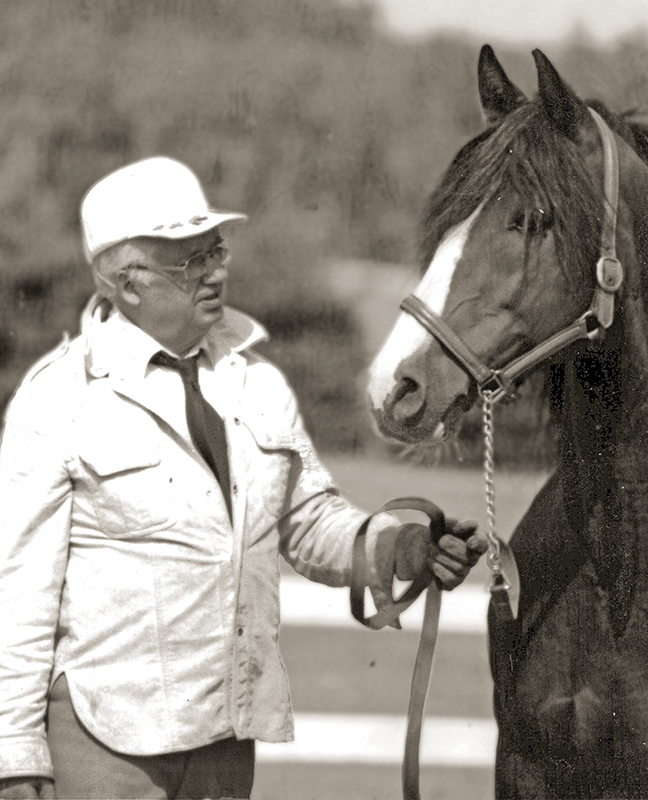
George Wade in 1985 with Jackson Mandate, a stallion bought as a weanling in 1967 along with his full brother Winston Mandate. Photo: Leslie Wade
“In 1967, he bought his dream property, a much larger farm about seven miles from town in Coldbrook. Here he was able to continue the field days, only now he was putting a number of people up in his house — he built a large one — and there would be a barbecue for all the participants after the show. Although he was a quiet man, his horses drew him out in his sharing of them. His daughters — three of us — all became passionate about them as well. Horses were our childhood. In fact, I wanted a bike rather than ride [horses] when I was younger, and he wouldn’t buy me one since he had the hope I’d be converted. He even paid me a quarter to be led around the yard, me in tears. He won out.”
George Wade’s passion for Morgan horses and their wellbeing was the reason he launched the Canadian Morgan Horse Foundation. Its aims were threefold - to promote the prevention of cruelty, neglect, and mistreatment of horses through education; to sponsor equine research by assisting universities, colleges, schools, and other qualified institutions to establish and maintain valuable equine research programs; and to award grants and scholarships to worthy students to aid their education in the equine community.
To raise funds for those goals, he was convinced the Foundation should have charitable status with Revenue Canada. The taxation bureaucrats, being less than enamored with things equine, took five long, frustrating years to deliberate Ward’s application but they finally granted the Foundation charitable status on February 1, 1983. The Canadian Morgan Horse Foundation was the first organization in Canada devoted entirely to horses to be recognized as a charity by Revenue Canada Taxation.
According to the Canadian Morgan Magazine, November-December 1985 issue, fundraising began in 1984. “Charitable work began that same year [1984] with research grants to the Veterinary Medicine Schools at Guelph, Ontario, and Saskatoon, Saskatchewan. This year [1985] another research grant was made to the vet school at Hyacinthe, Quebec, and an education grant to The Canadian Pony Club in Ottawa, Ontario.”
The Canadian Morgan Horse Foundation would become the Equine Foundation of Canada in the late 1980s, and the intent was to include all breeds under its umbrella. George Wade served as president of the organization from its 1983 inception to his passing in 1997.
In the early years, Wade recognized the shortage of equine vets and his Board directed that the Foundation provide scholarships to students going into equine practice. They included not only students at the Western College of Veterinary Medicine at the University of Saskatchewan and the Equine Research Centre at the University of Guelph, but also the University of Montreal Equine Centre and the Atlantic University Vet College.
Today, the Foundation continues to raise funds for scholarships, veterinary colleges, and research centres. Recently, the Foundation and Horse Council BC partnered to raise funds for a mannequin horse and a trailer. The mannequin horse is used to help firefighters and rescuers practice rescuing techniques and, with the trailer, the horse can be transported from one firehall to another for training purposes.

George Wade during the Apple Blossom Festival Parade in Kentville, NS circa 1986. Photo: Leslie Wade
The Foundation has provided a grant to the Equine Research Centre, University of Guelph, to purchase a new “super computer” which was utilized by Dr. Vale, a world-renowned specialist in equine pulmonary disease, for his research. A sling to lift horses after surgery was purchased by the facility at St. Hyacinthe with a grant from the Foundation. The Atlantic Veterinary College at the University of Prince Edward Island received a grant to support the development of chiropractic services for horses. Wade would have been extremely proud of the accomplishments of the Foundation he started.
Over the years, Wade had several horse riding accidents, at one time breaking a leg from a fall. In 1987 he had a serious head injury which, his daughter says, sadly changed him although he could continue his work and he rode until, literally, the day he died in 1997.
“He was 80 and his horse 30,” Leslie says. “[He] suffered a heart attack the evening after a ride and was rushed to hospital. He was very weak in hospital, not expected to make it by the second week. On Saturday his horse collapsed in the stall and had to be put down. My father went into a coma shortly afterwards not knowing his horse had died and he passed on Monday, two days later. They are buried beside each other on the farm, my father within a small wrought iron fenced cemetery and the horse just beside it. He had told someone the year before he died that he would pass through the pearly gates on a Morgan and we know that he did.
“My father’s dream was for his farm to be appreciated and used by others and we continue to carry on that dream as we host many horse activities, clinics, horse trials, shows, camp, pony club activities, and 4-H as well as a few competitive trail rides.”
John Ware
By Margaret Evans
Think cowboy and images come to mind of a rugged man riding a horse across the landscape of a bygone era. While those alluring images and the iconic cowboy lifestyle were glamorized in books, television shows, and movies, the fact remains that cowboys were part of the indelible fabric of the opening up of the Canadian and American west.
But one man stands apart from so many others. He was black. He had been enslaved. He was tough and a hard worker. In his day, he was the best cowboy that ever sat a bucking horse. He was good natured in a time when such social graciousness was seldom extended in return to a black man. He became a successful rancher despite the white-centric society of 19th century Canada. And in 2012 he was celebrated on a commemorative Canadian stamp during Black History Month.
John Ware was born in the mid-1800s and grew up in slavery. The exact details about his early life are not entirely clear. He was freed at approximately age 20 when slavery was abolished with the ratification of the 13th Amendment of the American Constitution in 1865. Leaving the plantation, he travelled to Texas and pursued a cowboy life, then worked his way north driving cattle to Montana.
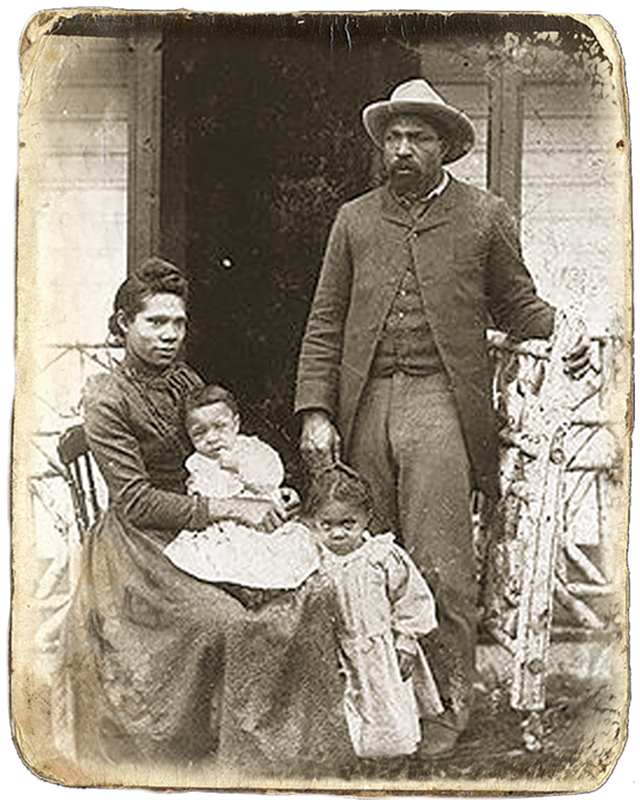
John and Mildred Ware with children Robert and Nettie, circa 1896. Photo: Wikimedia
According to the Glenbow Museum in Calgary, because of prejudice against black people, Ware was given the lower level jobs on cattle drives, such as being the cook’s helper or riding drag. A drag rider rode at the back of the herd in the dust and dirt, pushing up the stragglers, but Ware took it in stride.
Good fortune led him to cross paths with a man named Tom Lynch in Idaho, who in 1882 hired him to drive 3,000 head of cattle to the North West Cattle Company, which would become known as the Bar U Ranch in Alberta. The story goes that he was given a somewhat mediocre horse to ride.
But one day Ware asked an innocent question that would cement him in cowboy folklore. He asked his boss for a better horse. He may have had a sense that the horse he’d get wouldn’t prove to be “better” in the way he wanted. But he was used to people joking around at his expense and he would prove his worth.
The “better” horse was an ornery bronc that had bucked off every cowboy who’d tried to ride it, but Ware sat securely, anticipating every spine-jarring twist, turn, buck, and leap. By the time he dismounted, his companions’ scorn had been replaced by admiration for his skill and courage.
That became Ware’s hallmark. He built an enviable reputation by proving his skills with horses and the use of a lariat, staying on task no matter what was given him, working hard, and remaining true to his principles.
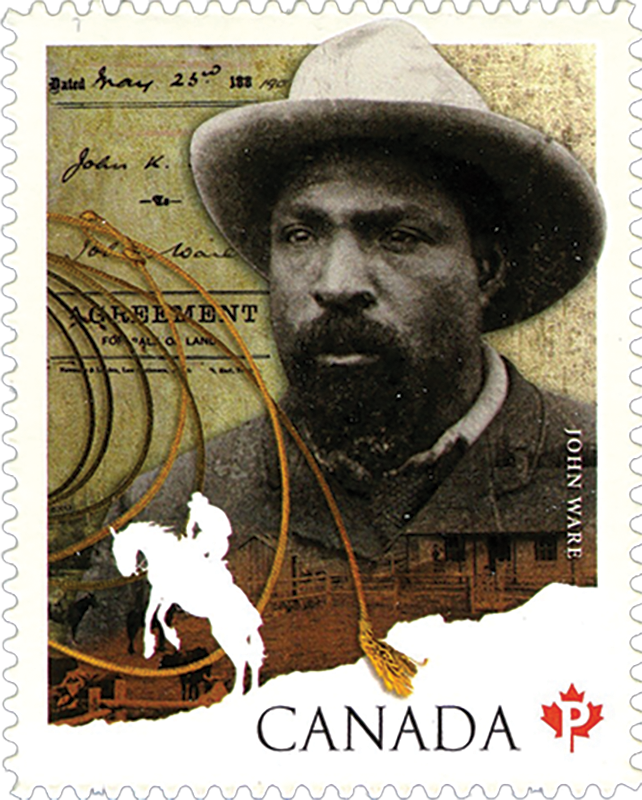
Postage stamp of John Ware in honour of Black History Month, issued February 1, 2012. Photo courtesy of Canada Post.
He quickly discovered that skilled, experienced cowboys were in high demand in Canada and decided to stay, finding work on ranches, including the Quorn Ranch west of Okotoks, Alberta. He deflected prejudice and planned to one day have his own ranch.
As the story goes, one day in 1882 Ware’s horse smelled something amiss and refused to drink from Sheep Creek. Apparently, John looked hard at the scum on the water, dismounted, and cautiously tasted it. He definitely agreed with his horse. That scum was oil. Thirty-two years later in 1914, Dingman No. 1 well produced the first oil in Turner Valley.
According to Glenbow Museum, in 1887 Ware started his ranch on the north fork of Sheep Creek in the Alberta foothills. In 1892 he married Mildred Lewis who had come to Calgary with her family from Ontario. They would have six children, one of whom died at age two.
Ware continued to earn respect among ranchers and cowboys, and that admiration was further endorsed when, according to the Canada Post website, he pioneered steer-wrestling and won his first competition at the Calgary Summer Fair in 1893. It set a precedent for what would much later become a highlight of the Calgary Stampede.
In 1901, Ware sold his ranch and resettled northeast of Brooks on the Red Deer River. But life began to take a tragic turn. The following year his home was destroyed by a spring flood. Undaunted, he rebuilt the cabin on higher ground overlooking what is now called Ware Creek. But tragedy struck again when, in March 1905, Mildred died of pneumonia and typhoid. Ware sent his grief-stricken children to stay with Mildred’s parents in Blairmore. The following September, Ware himself was killed when his horse stumbled in a hole and fell on him.
Ranchers from around the region attended Ware’s funeral in Calgary, the largest funeral the young city had ever seen. Ware had become a symbol of all that it meant to be a hardworking, trustworthy, talented rancher and horseman, qualities other ranchers respected and admired.

The John Ware ranch at Millarville, Alberta, circa 1896. Photo: Glenbow Archives NA-266-1
Despite the prejudices of the day, Ware was an influential industry builder who took the skills he had and made the best of every situation with humility and good humour. Today, Calgary is home to John Ware Junior High School. At the Southern Alberta Institute of Technology, the John Ware Building houses a student-run retail food market and the 4 Nines Dining Centre. The 4 nines (9999) was Ware’s original registered brand, later changed to 3 nines.
The National Film Board is currently in production on a documentary on John Ware titled John Ware Reclaimed. The director is African-Canadian Cheryl Foggo, who also wrote the award-winning play John Ware Reimagined. The film’s release date is late 2018 or spring 2019.
“John Ware is one of the people I admire most from the Canadian story, for a number of reasons,” says Foggo. “I was crazy about horses and cowboys as a young girl, but I didn’t see people of African descent represented in the books I read or films and television shows I watched about cowboy culture. Discovering the existence of a great cowboy and rancher of African descent who was instrumental in creating the brand of my city, Calgary, helped me to unify different aspects of my own identity. He met challenges with a combination of astonishing skills. I am also interested in the beautiful family life he created with Mildred Lewis Ware, his close bonds with her siblings and parents, and the pride his children took in his legacy, although he died when they were young.”
For Foggo, the story of Ware’s life connects people from a wide range of cultural and racial backgrounds, occupations, ages, and demographics. Ware would indeed be proud.
Guy Weadick
By Margaret Evans
Guy Weadick, celebrated as the founder of the Calgary Stampede, was born in 1885 in Rochester, New York. Fascinated by the cowboy lifestyle and not interested in following the family tradition in a career in law, he headed west in 1900 and found work as a cowboy from Montana to New Mexico, learning the skills of riding and roping, and especially trick roping. Soon he signed on with the Miller Bros 101 Wild West Show based at the brothers’ 101 Ranch in the Indian Territory of Oklahoma before statehood.
In 1906, Weadick’s travels took him to Chicago where he met Grace Maud Bensell, also known as Flores LaDue who, like Weadick, was a fancy roper and trick rider. She had left home as a teenager to join the circus. In five weeks, they married and began a lifelong relationship. They teamed up on stage for a trick roping show and performed together on the vaudeville circuit into the 1930s.
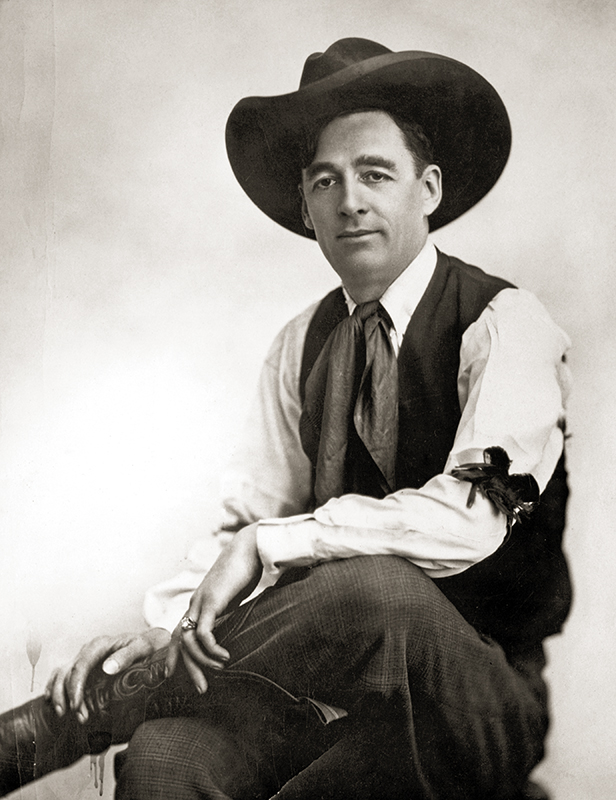
Guy Weadick. Photo: Glenbow Archives NA-3164-148
One of the companies they travelled with was the Orpheum Vaudeville. Vaudeville was lighthearted entertainment that included individual acts such as musicians, magicians, acrobats, comedians, trained animals, jugglers, singers, dancers and, of course, rope artists. The Orpheum Vaudeville travelled around the midwestern states and the Pacific coast.
While still with the Miller Bros 101 Wild West Show, the Weadicks travelled with them to Calgary in 1908. The federal government had awarded Calgary the Dominion Exhibition, a travelling fair designed to highlight the country’s different regions and opportunities. The attractions included a big parade and the Wild West Show of which Weadick and his wife were a part.
But Weadick was fascinated with the city and, with his natural gift for showmanship, performing, and promoting, he was convinced Calgary would be a great rodeo town. According to the Calgary Stampede website, Weadick thought it would be perfect for a “Frontier Days and Cowboy Championship Contest.” He discussed it with H.C. McMullen, the general livestock agent for the Canadian Pacific Railway, but the agent didn’t think Calgary was ready for it yet.
Weadick returned in 1912 and this time he and McMullen put together a program for the show. The Canadian Pro Rodeo Hall of Fame website states: “He was a man of broad vision and planned a stampede on such a magnificent scale that it would draw the best contestants from Canada, the United States, and Mexico. Together it would be the largest assemblage of Plains Indians this continent had ever seen. All he needed was the security of $100,000. This was not easy to find…” But they won the support and financial backing of the four most influential businessmen in Alberta, often called the “Big Four” — A.E. Cross, Patrick Burns, George Lane, and Archibald J. McLean. Cross was owner of the A7 Ranch and the Calgary Brewing & Malting Company, the first brewery in western Canada. Burns was a prominent rancher who, at the top of his game, owned land stretching from Cochrane to the US border. Lane was owner of the Bar U Ranch and prominent breeder of Percheron horses, while McLean was manager of the CY Ranch and an Alberta MLA.
They put up the money for Weadick to stage “the greatest thing of its kind in the world” and their enthusiasm reflected how Calgarians felt about their future.
The Stampede took place from September 2 to 7, 1912 to mixed reviews. It didn’t help that it rained, the daily schedule was unreliable, and many events didn’t start on time. There was no infield, no time limits, and many competitors were out of sight of spectators. Yet it drew some 80,000 people and the parade, which included about 1,800 mounted First Nations individuals, was a huge success with spectators.
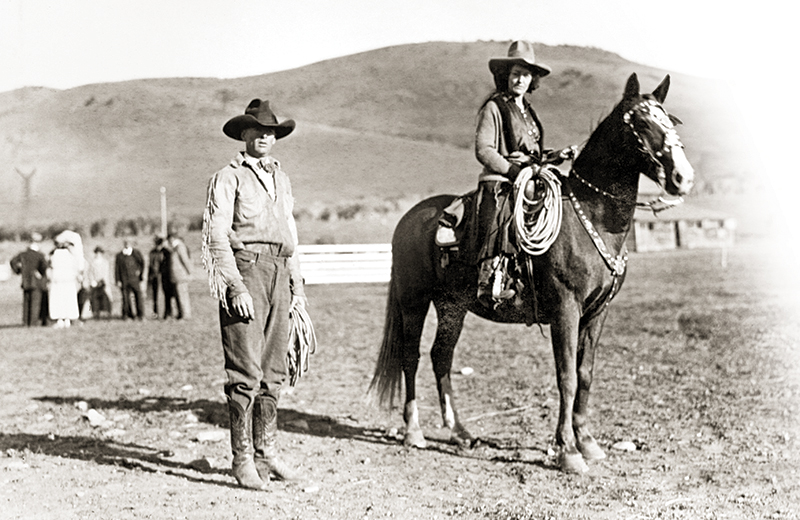
Guy Weadick and Flores LaDue at the EP Ranch, Pekisko, Alberta, 1923. Photo: Glenbow Archives NA-5652-37
The Duke of Connaught (Governor General of Canada at the time), his wife, Princess Louise Margaret, and their daughter Princess Patricia (whose name would grace Princess Patricia’s Canadian Light Infantry of the Canadian military) all attended the parade and rodeo events. Families from Treaty 7 Nations camped on the grounds, forming the original “Indian Village” that remains a Stampede staple today.
Weadick went on to promote a stampede in Winnipeg in 1913, and a rodeo in New York State in 1916. The next Calgary Stampede was in 1919 — the Victory Stampede — which Weadick managed in celebration of returning troops following World War I. The Stampede did not become an annual event until 1923 and Weadick managed it until 1932 when, according to Glenbow Museum, he was fired over a dispute with the Stampede Board.
According to the Museum, Weadick purchased a ranch in Eden Valley, west of High River, in 1920, using it as a guest ranch into the 1930s. He and his wife entertained many influential and famous people including Edward, Prince of Wales.
Ill health forced the couple to move to Arizona for a warmer climate, and Flores died in 1951. In 1952 Weadick married Dorothy Mullins, who had also competed in the first Stampede, but Weadick died the following year.
The Guy Weadick School in Calgary was named in his honour in 1979. Weadick was inducted into the Canadian Professional Rodeo Hall of Fame as First Builder July 12, 1982.
Alfred ‘Alf’ Fletcher
By Kathy Smith
Alf Fletcher of Westbank, BC, was a respected judge and steward, and a former president of Equine Canada.
Fletcher grew up in the south Okanagan in the 1930s and 1940s, and pursued his interests in riding at a time when the sport barely existed in BC. He had strong riding skills and participated in various disciplines from tent pegging to jumping. His commitment to his community was evident in his career was as a firefighter and fire prevention officer in Kelowna, BC.

Alf Fletcher and his wife, Heather. Photo courtesy of Heather Fletcher
Fletcher was a Senior Judge for hunter, jumper, and Western disciplines, and also judged hunt seat, saddle seat, and stock seat equation. His versatility was evident as he was also a Recorded Judge for several breed sports.
As an EC Senior National steward for all EC disciplines, and an FEI-X steward for jumper and dressage, he was popular for his sense of humour and strong sense of fair play. David Esworthy, a respected FEI judge and a steward himself, commented that “Alfie worked tirelessly to ensure that all competitors were on a level playing field. Fairness for the competitors and good care for their horses were always paramount in his interpretation and application of the rules. He would not tolerate cruelty, in any form, to any of our four-legged friends.”
Many of Canada’s stewards were mentored by Fletcher, among them FEI steward Maureen Walters. “He’s the one who taught me the most about stewarding,” she says. “He always told me that stewards should be out with the people and the horses, and always be accessible.”
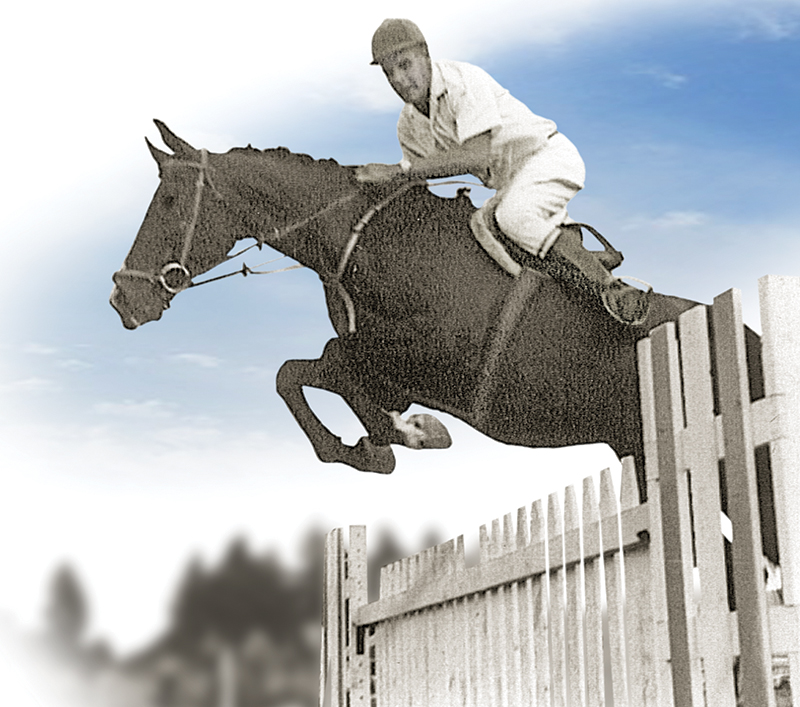
Alf Fletcher jumps Quest. Alf pursued his interest in horses before equestrian sport was widespread in BC. Photo courtesy of Heather Fletcher
Fletcher took a personal interest in the careers of the riders he knew.
“Alf was always one of my favourite people to see at the horse shows,” says Olympic dressage rider Leslie Reid. “He always had something friendly to say and you got the feeling he was glad to see you. He was very efficient and knowledgeable at his job, and he knew so many people so well.”
From 1997 to 2000 as president of Equine Canada, Fletcher assisted in the restructuring of the national federation with a commitment and vision for a strong and viable equestrian industry in Canada. He was named Equine Canada’s Volunteer of the Year (2001) and Jump Canada Official of the Year (2009). He was also an Honourary Lifetime Member of Horse Council BC (HCBC), and each year HCBC awards the prestigious Alf Fletcher Youth Sportsmanship Award to an individual whose conduct exemplifies good sportsmanship.
When Fletcher passed away at age 77 in 2009, Akaash Maharaj, then CEO of Equine Canada said, “He had a formative influence on generations of Canadian horsemen and horsewomen and on our national equestrian system itself. Neither our affection for him nor his legacy will ever fade.”
Jack Pemberton
By Kathy Smith
Jack Pemberton discovered his passion for horses and carriages when he was in the Royal Canadian Air Force. He taught himself to drive, became highly skilled at restoring carriages, showed at fairs across Canada and the US, and became a champion at the Royal Agricultural Winter Fair.
Born in Toronto, he lived there until he and his wife, Lillian, bought farm property near Georgetown, Ontario. His commitment to horses and driving led to his involvement with many associations and equine organizations to encourage and promote carriage driving around the world.

The Equine Canada Lifetime Achievement award is presented to Jack Pemberton (right) by EC president, Al Patterson.
Pemberton’s impact on equine sport is huge. He attended the first-ever meeting of the Carriage Association of America in 1960, and over the years held various roles in the association including director and chairman. He was made an honorary director in 1988.
In 1968, Pemberton represented Canada in carriage driving at the FEI. It led to a long-time involvement with the international organization and he became an FEI driving judge and chair of the driving committee from 1995 to 2003. He gave back by donating a driving trophy to the FEI World Cup Driving Final. The first Jack Pemberton trophy was presented to Australia’s Boyd Exell in 2012.
Pemberton’s involvement with the Royal Agricultural Winter Fair began in 1964 when he first exhibited in the coaching class. He became a director for the Fair in 1974 and served as the Fair’s president in 1975, and from 1978-1979. He was also involved with establishing the Ontario Equine Research Center in 1981, and later served as a chairman on the Center’s Advisory Committee for six years.
More than 20 equine associations have benefitted from his involvement over the years. He has been made a life member of the British Horse Society, the Canadian Combined Driving Association, Drive Canada, the Canadian Hackney Society, and the Eastern Ontario Pleasure Driving Society. He was also one of the founding directors of Drive Canada and the American Driving Society. In addition to all his volunteer association involvement, Pemberton was also the chair of the Canadian Pleasure Driving Championships.
Pemberton was the inaugural recipient of the Lifetime Achievement Award from Equine Canada in 2007, presented to an individual whose contributions to the Canadian equestrian community are considered exceptional by their peers, and whose lifetime of service and dedication has contributed directly to the growth and development of the Canadian equine industry.
Cara Whitham
By Equestrian Canada
Cara Whitham’s remarkable career in the equestrian industry has spanned everything from high performance dressage rider and certified coach to world-renowned judge, industry leader, and volunteer. A little known fact about Whitham is that she was the first woman in Canada to go for her jockey’s licence.
During her riding career, Whitham was named to the Canadian Dressage Team short list numerous times, and she earned many Canadian and provincial grand prix and grand prix freestyle championship titles. She has also had a remarkable impact on dressage within Canada and around the world as a certified High Performance Coach and Coach Evaluator, and FEI Course Director, conducting clinics in Asia, Australia, the Baltics, England, New Zealand, North America, South Africa, and South America.
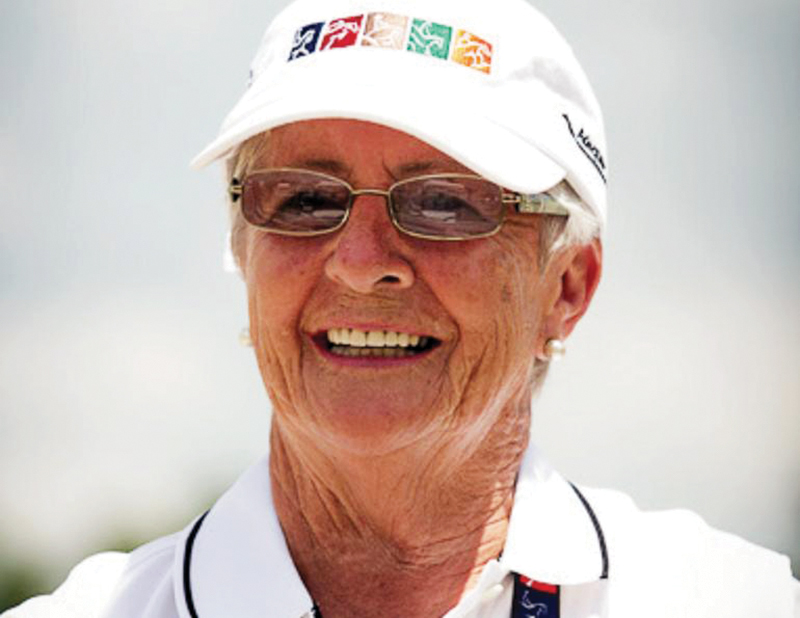
Photo: Equestrian Canada
First appointed chef d’équipe for the Canadian Dressage Team during the four-year European tour leading into the 1984 Los Angeles Olympics, Whitham is also renowned for her input into the high performance plan that produced Canada’s only Olympic Team Medal in Dressage to date – the Team Bronze Medal at the 1988 Seoul Olympics. In addition, she was the chef d’équipe for the Costa Rican Dressage Team, helping them bring home the Team Gold Medal from the 2013 Central American Games. Subsequently, Costa Rica qualified for the Pan American Games for the first time in their history, attending the 2015 Games in Toronto, where Whitham once again stepped in as chef d’équipe. She has also had a celebrated career as a judge, and continues to be in high demand today, while also mentoring many judges in Canada and around the world.
She has held the record of being the only official to obtain FEI 5* judging credentials for both Dressage and Eventing. Plus, she received FEI status as a Dressage Technical Delegate, Eventing Steward, and Dressage Course Director. She was recently appointed Technical Delegate of Dressage for the 2018 FEI World Equestrian Games in Tryon, NC.
Whitham’s judging career has taken her around the world and to the very top of the sport. She was appointed to the Dressage Ground Jury for the 2003 and 2011 Pan American Games, the 2005 European Dressage Championships, and the 2010 FEI World Equestrian Games (WEG). On the eventing side, she was appointed to the Eventing Ground Jury for the 1998 and 2002 WEG, as well as the 2004 Athens Olympic Games.
Recognized internationally for her knowledge and insight into equestrian sport, Whitham was hired as a television commentator for the 2007 WEG, as well as the 2004, 2008, and 2012 Olympic Games.
In addition, she has been instrumental to the competition system in Canada. She has organized over 200 national and 30 international competitions, and held the position of Technical Advisor for the Coup des Ameriques in Blainville, QC – which was the first FEI Dressage Team competition held within North and South America. She also founded the Canadian FEI Youth Championships and was a leader in introducing the Event and Dressage Young Horse classes in Canada.
A former Manager and Director of Dressage for Equestrian Canada (EC), Whitham has given back to the organization throughout her long and illustrious career, providing invaluable service through various volunteer roles, including Chair of the former Dressage Canada Committee. She continues to donate her time and knowledge to the betterment of Canada’s equestrian industry today, and is a current EC Category A Member, as well as current Chair of the Officials’ Task Force.
Whitham’s contributions to equestrian sport and industry are immeasurable, and Canada is fortunate to benefit from her dynamic and world-class talent, bottomless commitment, and invaluable experience. She was the recipient of the EC Lifetime Achievement Award in 2016.
John Scott
By Kathy Smith
John Scott, the owner of John Scott Productions & Motion Picture Animals, received the 2007 Alberta Horse Industry Distinguished Service Award for his decades-long dedication to making Alberta a go-to province for movie production. In 2008, he received the City of Calgary’s Signature Award for his accomplishments and contribution to bringing signification recognition to Calgary.
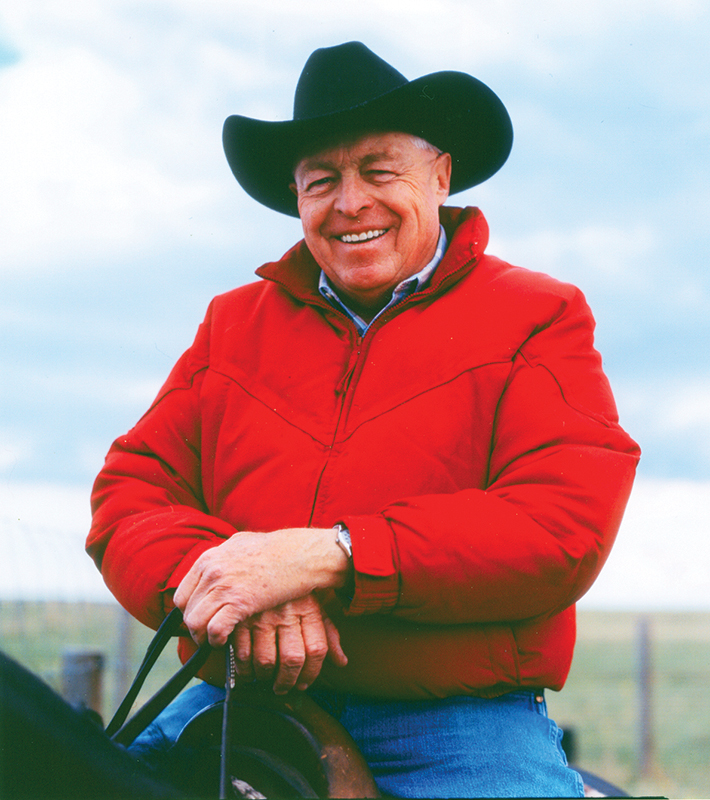
John Scott. Photo courtesy of HIAA.
Scott’s ranch and production company based in Longview, Alberta has worked on five Oscar-winning films including The Revenant (2015), Legends of the Fall (1993), and The Unforgiven (1992), and the Emmy-winning film Bury My Heart at Wounded Knee (2007). More than 150 productions for film and television as well as numerous commercials have been shot at the ranch where Scott offers his services as wrangler, producer, host, promoter, negotiator, stunt coordinator, talent scout, and actor.
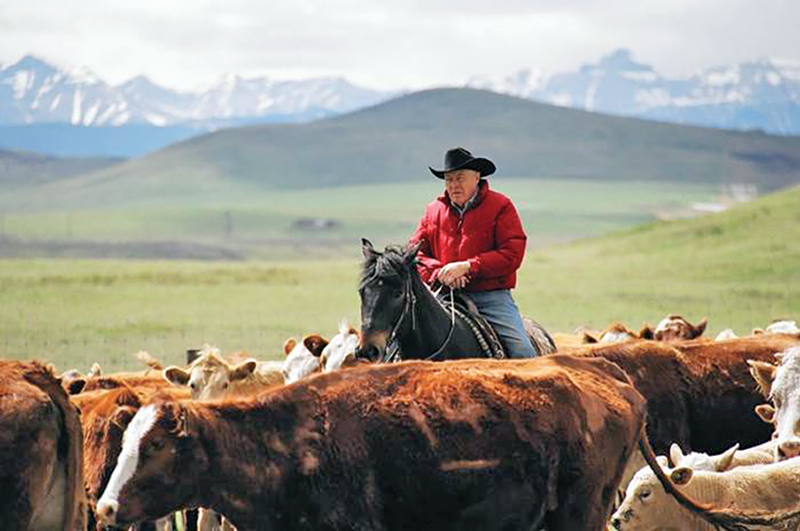
The John Scott Ranch is a cornerstone of Alberta’s multi-million dollar movie industry. Photo courtesy of HIAA.
On the Horse Industry Association of Alberta website, he is described as “a man of many hats” who “sees his task as quite simple — help capture the jaw dropping majesty and breathtaking splendor of the diverse Alberta landscape. Combine it with unique heart-stopping suspense and action. Sneak in a history lesson. Leave the decision makers champing at the bit to return. And all the while leaving the precious landscape unharmed and his two- and four-legged team members happy and safe from harm.
“John Scott’s world is all about opportunity – the opportunity to promote his home province; the opportunity to create work for so many people and animals; the opportunity to live each day a meaningful life centered around horses and the Western traditions; the opportunity to have the camera tell meaningful stories about people, places and events dear to his beliefs; the opportunity to promote and preserve; and the opportunity to teach, train, and mentor.”

John Scott (right) and Roy Rogers. Photo courtesy of the Calgary Stampede.
Known as the “Hollywood Hand,” John Scott has provided a wide range of services to the motion picture industry for more than 30 years.
Recognizing equestrian industry builders isn’t only about the awards they received, their achievements, or their positions. It is who they are or were as people working with the skills they had, in the time they had, and with the love they gave to an industry they were so passionate about. It was their compassion, their willingness to share knowledge, enthusiasm and encouragement, and their dedication to the horse that made them so remarkable. They left the starting gate of their lives, rode the course of their careers, and crossed the finish line setting new levels of excellence and vision for all of us to follow.
Quick Links
- Bill Collins
- Faith Berghuis
- Peter Cameron
- Gayle Ecker
- David Esworthy
- Dr Gillian Lawrence
- Dr Sherman Olson
- Edward Plunket Taylor
- Guy Weadick
- Ron and Marg Southern
- George and Dianne Tidball
- Dr Hugh Townsend
- George Wade
- John Ware
- Alf Fletcher
- Jack Pemberton
- Cara Whitham
- John Scott
Related: Queen Elizabeth II's Equestrian Legacy: Her Passion for Horses and Impact on the Sport
Related: Horses' Historical Hoofprints
This article was originally published in February 2018



